#so i can appreciate its visual/aesthetic aspects instead
Note
Do you enjoy underfell? I thought you disliked aus /genq
i don't dislike the concept of AUs itself, I'm just not a fan of like... the subculture that spawned around them in the UT fandom specifically and how it eventually took over almost all canon content (especially when it limits itself to the bros)
i like aus visually! i am an artist at heart after all. it's just that, if I'm going to care about them as stories and not just fun design ideas, my bar is uhh almost impossibly high the further you move from canon lolol.
#uf being one of those! the story is centered on certain characters (mainly asgore) behaving very ooc#so as a stickler for canon I don't have much interest in it#but there is a very clear visual idea and motif in the redesigns that ties every character together very efficiently#and also fucks like a rabid rhino#so i can appreciate its visual/aesthetic aspects instead#i mean you can't understate the impact that good *artists* specifically had on the proliferation of aus back in the day#good writing is almost inseverable from good characterization because dialogues and characterization ARE an integral part#of what makes writing good. while good art (as much as it too is tied to its own conventions) is free-er from the bounds of accuracy#as was as being easier & faster to consume. writing has to be read first. you can just look at a piece of art and go ''wow that looks sick''#without thinking about logical details/accuracy#you can show a pic of sans to an artist who's never touched the game and they might draw you the most gorgeous piece of art you've ever seen#it's significantly harder to do for writing#swap aus are a fun design challenge to see how you'd incorporate different aspects of some characters visual signatures into another#it's a game of translation of sorts. but if you want to treat it like a story well... the matter becomes a lot more complicated#answered asks#au tag
103 notes
·
View notes
Text
Doom Eternal art style/aesthetic/tone stuff
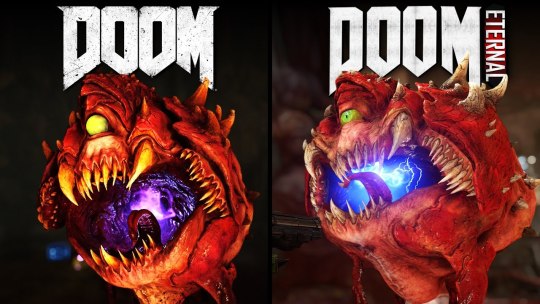
(Just wanted to post an image, this is a YT thumbnail from Nick930)
To this day, there's still a lot of talk about Doom Eternal's art style but i also think some opinions and points of view are more popular than others, so in this post i try to bring up some opinions or observations that are not as popular.
Partially because i like to think of Doom as a series that a lot can be said (And done) with.
But also because there's opinions that i think could be more "agreeable" to people in "different sides" yet seem unpopular.
THIS POST IS HUGE, BE WARNED
2016's tone and it as a "middleground"
When D2016 was revealed, some fans didn't like the visuals for either being too limited in terms of coloring or even criticizing some art style designs, such as the demons looking "like something out of Warcraft" or Doomguy's new armor being heavily compared to Halo's Master Chief.
But since release, fans begin to appreciate parts of this visual and tonal direction.
I also remember this old screenshot edit meant to make 2016 colored like classic Doom:

My one criticism of this image is that it forgets why classic Doom was even that colorfull to begin with: The textures and assets had a certain "variety of context".
So in some floors, there'd be flesh and then there'd be marble walls, then flesh walls with metal pipes and some evil eye candles etc.
This means Eternal tries to "make up" for 2016 and be more colorfull, while either bringing back some classic designs or get more creative.
D3 influence in 2016
D3 did have its influence in this game, specially the red/orange Mars bases, some of the rocky Hell and even the modern Hellknight.
But D3 being a horror game also means some of its designs (For better or worse) were more experimental and extend how weird Hell is.
A contrast to 2016 having a more "unified" aesthetic on its demons, like the chittin anatomy.
D3's tech is also more "outdated" since Doom can often be associated with a "used future" sort of look, while 2016 looks more advanced.
2016 between D3 and Eternal
To some, 2016 has the perfect middleground of being a gritty, brutal game compared to D3's grey corridor horror and Eternal's cartoonyness.
But i also see it as a very limited direction, since both D3 and Eternal can have some variety but through opposite directions.
Be it Eternal wanting to be a nerdy comic book universe or D3's for-better-or-worse experimental surrealistic demons.
This also means that if D3 had a follow up, it could have been to D3 what Eternal is to 2016: Or rather, a game that instead of being between D3 and Eternal, is somehow the opposite and therefore almost an inverse to 2016.
You'll notice people throw around words like "gritty" and "cartoony" when comparing 2016 to Eternal, yet Doom and games like Monolith Productions' Blood are proof that the 2 can coexist and be done in a lot of ways.
I even wrote about how horror always had a place in Doom and can even coexist with action or cartoony fun.
But it's also the difference between an old FPS feeling like a campy B-movie with some eerie practical effects and a "Saturday Morning Cartoon with blood and demons".
How much of classic Doom is in Eternal?
Because there are still concepts of old Doom not in Eternal like specific assets you'd find in the diverse classic Hell or the Phobos UAC bases.
Certain philosophies set by 2016 are still present and maybe Eternal's designs not being 1:1 to old Doom is a good thing: It means you can modernize an old idea and still have a unique take on it.
But it's also because Doom is a series whose setting is not to be taken too seriously, so even some interesting aspects are overlooked.
I even tried to make a post attempting to analyze the OG Doom aesthetic.
It could also be that id had to make these designs feel fresh because anything more faithfull for classic Doom might as well be something already done in fan projects.
"Professsial/goofy/cartoony" in some places and not in others?
People say Eternal is too goofy/cartoony but in some ways, you'll find the game is still trying to be series or professional as an AAA title.
The art style is still very detailed (Be it because of lore, the graphics since id is a tech focused studio or even because of certain trends) while classic Doom's aesthetic had a rather "B-Movie style" method of how some sprites were made and has aesthetics people nowadays won't take it seriously (Or never did to begin with).
Mick Gordon's music tracks are meant to sound aggressive while Bobby Prince's classic MIDI tracks come in a variety of genres and songs that almost sound like jazz or something unrelated to metal or suspense.
(This is also why this meme that i just stole from r/Doom doesn't work because of how poorly treated Mick Gordon was: To add more context, the original meme's use was on cartoony platformers like the one in the right)

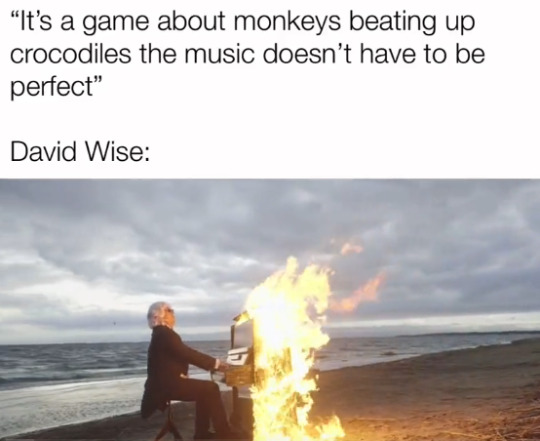
Even the writing in Eternal's character lines or codex entries tries to suit an "epic fantasy style" of writing while OG Doom's intermission screens and manuals have campy 90's writing.
And despite the "arcade/self-aware" pick ups, Doom Eternal still tries to make animations satisfying and with a lot of effort and "believability" while classic Doom has obviously limited animations, resolution etc so Glory Kills can't exist there.
("Glory kills" in Doom mods are either animations of Doomguy's hand being seperate from a demon still retaining a pain frame or Brutal Doom's long third person animations)
Just compare chainsaw kills in Eternal vs classic Doom or even how Eternal adds "context" to level environments and classic Doom levels are abstract.
Eternal tries to feel "videogamey" in a self-aware "wink at you" way while old Doom "just is".
It also happens that various objects in Eternal come in different degrees of feedback, between the glowy pickups and the yellow monkey bars trying to fit the environments.
I also thought a cel-shaded art style could work in Doom and even wrote reasons why.
"Safe?"
Doom was always cartoony but what if people worried about Eternal's aesthetics because they thought of it as "safe edgy"?
Sounds like nothing to worry about, although you'll find interviews where Hugo Martin describes the game in some ways like "violent fun for the whole family", "like a bloody Saturday morning cartoon" or mentions of not letting characters curse and the history behind the Whiplash's design.
Maybe Urdak is a big example: Doom finally gets a "Heaven" but it's not a very direct reference to Heaven as if id had to be creative.
Doom was never edgy but i can see someone mention the series coming in a time of the "Satanic Panic" or how we had designs like the Vagary and Cherubs from D3 or even "those holes" behind the Caco's.
At the very least, Doom Eternal's gore did not have the same issue as Mortal Kombat 11 and TLOU2 where devs were forced to look at real gore for the sake of "reference material".
(Anyway, i can see someone say this is the real reason why Doom and AC crossovers even worked)
Cartoon/comics/media influences
Eternal definitely has different influences from old Doom as seen in interviews but even by looking at the game's tone and some details, you get the idea of it.
I recall someone once saying "Eternal wants to be 90's while classic Doom wants to be 80's" but you can also say "It tries to be a comic book but instead is more like a cinematic adaptation of one".
id Software bringing up He-Man or superheroes may seem weird in a series inspired by Aliens, Evil Dead and HR Giger.
Maybe calling Doom "cartoony" sounds off if it comes from the mindset of "cartoons are for kids" despite the notion that animation for adults (That isn't comedy) exists and then you have all these debates about animation or "media literacy".
Because one thing is Doom fans reacting to this, another is id themselves since they're also media nerds themselves.
Maybe if id mentioned something like 2000AD and Heavy Metal as far as comic influences go or the Heavy Metal movie for cartoon influence, some people would be more relaxed i guess.
The UI design
This technically relates to another post of mine: Eternal having a glowy HUD for the sake of feedback but how 2016's HUD was a bit generic.
Then there's also the logo and how simple it is because of minimalism, since classic Doom's logo benefits from the details.
Feedback variety
I already mentioned this part but as Eternal focused more on feedback, you'll notice that objects have different languages.
Lives, secrets and blood punch pickups are glowy objects meant to feel videogamey.
But ammo pickups still resemble objects that technically "exist" in the worlds (Even with a shiny coat).
And then there's the yellow monkey bars and scratches for climbable walls which suit the scenery naturally.
In the series, level objects and pickups always had specific themes (Mostly UAC and Hell) to "suit" the environment, even if classic Doom had sprites always facing one direction.
Eternal technically needed this because its graphics are a lot more detailed and the gameplay is faster (And in 2016, some people were confused with some objects blending in with the environment or the health pickups looking like weird sci-fi things and not something obvious).
But because 2016 even had an Hell version of exploding barrels and automap update, some would love to see the settings of Urdak and Argent D'Nur being expanded through their themes and aesthetics.
The memes and humor
You could say 2016 planted the seeds for what Eternal was going to be, with one example being the reason for the Doomslayer.
And it's not just the obvious "Rip and Tear" 90's comic, there could be more:
That popular Death Battle video where Doomguy loses against Master Chief (And maybe any Doom fan that really hated Halo).
Maybe some imageboard copypastas and comics (Faraz Parsa used to be some comics about Doomguy).
Basically, any time someone tried to push Doomguy as a videogames Chuck Norris.
Brutal Doom but there's also debates around it like the melee in Doom 4.10, Serious Sam 3, how popular the comic was etc.
Because even in the comic, Doomguy says "Rip and Tear" and then he fails to do that to a Cyberdemon and runs way.
Same comic where he gets hit but still fights back, meaning that despite the dialogue, you could see the comic Doomguy as a potential personality of ingame Doomguy (Which is ironic for something made by people that weren't that knowledgeable in the games but y'know, it's Doom).
Maybe the problem with "rip and tear" might be the focus on a comic that wasn't really a significant piece of history despite the memes?
To some, it could be like a Zelda game focusing too much on Morshu from the CD-I Zelda's or Sonic referencing Sanic.
Maybe you could even mention how Doom has a lot of other memes that have yet to be used too much.
Either way, how some people feel about the use of "Rip and Tear" is probably similar to older fans of Yakuza/Ryu Ga Gotoku who suspect later fans are only in the series because of memes.
Doom was never a serious series but that sentiment can be justified, specially in a series where the fans did so many cool things and it's an important gaming series as well.
The stuff at the Fortress of Doom is mostly done for the sake of easter eggs and fun, i'm not even sure if the collectables are canon.
But i can see that being compared to how Duke Nukem would play games about himself or is essentially a "fan of himself".
Visuals vs gameplay?
You know how people complain about the difficulty? I wonder if those people feel a mismatch between gameplay and visuals.
As in: If Eternal was even grittier than 2016 or D3, its challenging gameplay would feel justified.
Or if Eternal was easier, its visuals wouldn't be out of place to these people.
Maybe people also complain at Eternal's gameplay because of the Doomslayer: The logic being that if you play as a canonically very powerfull character, the game should be easy.
Doomslayer and the appeal of the DOOM guy
Even though the Doomslayer is a product of fanservice, there are fans that have different reasons for why the Doomguy is appealing.
To some, it might be an underdog appealing of the one UAC soldier who somehow survived but could have been dead.
From the classic box art showing Doomguy fighting while hurt, to the bloody face in the status bar and the fact that Doomguy shared his green armor with other soldiers.
Romero wanted him to be a blank slate, hence the lack of a name and "Doomguy" being a fanmade term.
2016 changed this by making him as an artifact the UAC discovers and giving him a unique armor.
It's also partially why BattleMode exists in Eternal instead of a deathmatch mode because "there is only one Slayer", even if in fighting games nobody has an issue with there being more than one Ryu, Terry, Scorpion and so on.
D3 also had an "underdog" appeal but it felt different since the some aspects of classic Doomguy weren't carried over, so we never really see the marine with a bloodied face that can still smile.
Even though Eternal did more to reminding the player how great the Slayer is, it still toned down the anonymity and gave him pain voice sounds (Which people thought ruined the "silent/mysterious killing machine" appeal set by 2016).
While a very silent killing machine has appeal, i wonder what if Doom went the opposite direction and did more to disfigure and dismember Doomguy but made him laugh and scream loud like an edgy fanfic.
(Imagine a status bar face Doomguy with half his face peeled off and he cackles maniacally, something i don't think even a Brutal Doom addon did before)
Meanwhile, some people also compared Doomslayer to Guts from Berserk which is interesting because modern Doom almost makes it as if Doomslayer must always be on top whereas Berserk usually shows Guts struggling even if he gets better tools.
(And of course, the kind of content that Berserk has compared to Doom)
Guts and Casca have a brand that made them doomed while Doomguy has a brand that spells doom to his enemies.
Lot of people argued about whether or not Doomguy should show his arms but not enough about his helmet being green when it used to be white/gray.
Let's also not forget when 2016 had Doomguy getting glory killed by his enemies in some game over deaths and even 2016 marketing had him being killed (One trailer even had a death scream).
I just heard that Jason Statham had in a contract that he must never lose a fight in a movie and it reminded me of how in Marvel vs Capcom Infinite, Disney didn't want Marvel characters to lose in that game's marketing (Didn't that Avengers games had a QTE section with Thor that you couldn't lose as well?).
I wonder if Doom fans worry about Doomguy having that issue.
Hell and demons
I wonder if most people do care about D2's manual already giving cybernetic demons a backstory (One of the few OG lore bits that the new games retconned) and the aesthetic present in the original games.
Because i already talked so much about how diverse and unique Doom's Hell always was and its potential.
But also how some demons had bizarre designs (Even/specially in D3) and how it compares to 2016 having a "unified chitin biology" sort of rule.
Because with how much you can explain how demons work or the aesthetics of their looks and Hell, you may not want to make them feel limited or too grounded (With the one limit being that shotguns can still kill them).
Because i even said that "horror" in Doom could mean creative, surreal designs and it could complement the power fantasy aspect of the Slayer.
Some people prefer the 2016 Baron over Eternal's but i like to think that the fire/lava aesthetic justifies the "rocky" bits of the modern Baron.
You also barely see certain concepts like the 7 deadly sins or layers of Hell being referenced, even if Doom was never "biblically accurate".
I remember someone's article about Doom saying "where did the weird go" and they even made these observations about Hell being a colorfull fleshy landscape or how the Mancubi got their cannons.
The direction of the lore/story
Some people prefer how 2016 was more subtle and focused while Eternal felt like it wanted to give more and starts off some time after 2016 (Hence people expecting something to fill the gap, like a supposed comic).
Then there's the tone and direction, feeling more like an "adventure" than a "mission", though Eternal wanted to raise the bar in this series in a way never done before.
There's also decisions that divide some fans like Samuel Hayden being the Seraphim: Partially because Sam had an appeal of being this morally questionable company boss as a robot.
But also because of how the UAC is tied to a Maykr after they're already related to demons in a way: Too many connections between different worlds can make a universe feel smaller.
TAG2 had a lot going on with Immora and the Dark Lord but i already explained it in some posts: Let's just say it's usually a matter of "not being epic enough for a series that people want to be super epic".
Because everyone already knows about Doom being a series whose own story barely mattered and was always a mess, but the new games wanted to focus on it with lore, cutscenes and even marketing and products like the "lore book".
Personally, i think Doom's setting works better if it's just a cool idea that can be done differently because it could make it easier to "walk away from the bad ideas".
Because the problem might not even be what will happen but rather what CAN'T happen in a series with fanservice and an "everyone likes it" status.
In both certain games and the fanbase, you can witness a versatility set by Doom and it can be owed to the "unfinished" presentation of the classics and how people viewed them.
Even the new Wolfenstein games are seperate from the previous Wolf titles, that Old Blood cut off RTCW from the new timeline.
So in a way, more of this "Doom universe" could still exist but make it coexist with another version of it like one where Samuel Hayden and the Seraphim are different characters or the Sentinel have different origins. And this could be done for fun and not just for the sake of apologies.
The fanservice can be basic despite its aim being at older fans, because we all know the major focus is on being its own thing and appealing to newer fans (And because i guess "bigger fanservice to older fans" might as well be outright copying ideas from mods).
To some people, Doom Eternal feels like a "diet Warhammer 40K" which i guess is still less far off than comparing Doom to Berserk or Shin Megami Tensei.
I can also see someone say "they turned Doom into the MCU" and maybe there's some truths on what kind of people/influence id had in mind.
I also think the problem with the Sentinel vs Immora fight is how it felt "too soon" while the MCU had build up for its "final fight" in Endgame.
SPECIALLY because we didn't get enough material for a character like Valen and the fact that Doom doesn't have enough characters to suit this "final battle themed reunion" that happens in a lot of other media and sagas.
(And i guess how it involves the Sentinel when Earthling soldiers were the more common concept in the series or even how Earth is okay while the Sentinel are almost extinct?... or even how Doomguy had to go to Earth to use the gate of Divum but the Sentinel still got there?)
But think of the "MCU/Whedon dialogue speak" that's present in so many things right now: Doom Eternal did not have that annoying writing trend and be glad about that.
Still, it feels like Doom only has lore now because other nerd media has it (I think in a 2020 February stream, Hugo Martin even said something like that: Star Wars has a big universe, so why can't Doom?).
Maybe people worry Doom is becoming like other series, specially since its universe was mainly "UAC and Hell" unless Urdak and Sentinels is enough.
Because again with fan content, you get the feeling so much could be done with a small selection of worlds.
What else? Oh yeah Doomguy had a wife and kid but they're just a photo placed somewhere in the Fortress of Doom.
Because the mere idea of Doomguy having a family is easy to miss, it's hard to take him as a "tragic figure" because it's as if id kinda thought "this is one of those ideas that could have been in a 7th gen military FPS or the cancelled D4, that's why we came up with the Sentinels".
(And QC already gave Ranger a family, while Doomguy's case involving a rabbit is more unique)
To some people "expanding" Doom is simply adding anything to the series regardless of canon and that's why i think MetaDoom is one of the best mods: It makes Doom feel bigger than it is.
The direction of Eternal's lore makes it as if Doom "switched genres" due to its original influences vs the new ones.
Kind of like how Planets of the Apes is still about monkeys taking over Earth but you can tell that the recent movies do not have some elements that the first 5 movies had (And if Doom 3 is closer to the original premise but is a more flawed entry, then maybe that's equivalent to the Tim Burton Apes movie?).
Even Turok is like this.
Anyway, Tim Willits lied again because NO: Doomguy was never inspired by WH40K Space Marines, TIM YOU WEREN'T EVEN AT ID UNTIL 1995!!!!
I can also see someone bring up Midnight and this culture of Youtubers but wait when i post the "Doom fanbase status" post here on this blog.
Trends
When i think of why modern Doom looks this way, i see it because of trends.
The aesthetic behind the demons (And maybe the Night Sentinel) can be compared to some franchises.
The demons with the focus on chitin/shells/carapace/etc can be compared to any other series aiming to look "comic book-like" or inspired by Warhammer: If Warcraft, Dota, Darksiders or something else came to your mind, there might be a good reason.
It's something to keep in mind on why Demon Souls fans weren't into the PS5 remaster's changes from the original games.
And even the Night Sentinel can be compared to some interpretations of fantasy involving "magic tech", meaning if they existed before then maybe they could have been more comparable to Heretic and Hexen.
At the same time, this can apply to the originals since lots of older games were also influenced by Aliens and HR Giger.
Still, when trends like these happen i wonder if it has anything to do with industry standards or certain things thought in art schools because there's also a matter of knowing more media and how it can portray sci-fi or fantasy elements.
It's not like the originals and that's fine
Despite all the observations to make, it can also be pointed out that being different from the previous games isn't a bad thing.
I think the reason why people labelled these games as "the one franchise reboot that is JUST LIKE the original" is because the idea of a franchise reboot/revival being good is rare to some.
Though the lesson isn't really "finally, it actually is like the classics" but rather "it's different yet it worked", specially in a series with so much documentation, analysis and on-going fanbase culture and modding.
(Or maybe Doom does have a "reverse Sonic" syndrom where everyone must like it, but maybe i could cover that in a report of something i wrote about the Doom fanbase)
In one of this "Microvideo showcase", i liked that MatthewMatosis even came to this conclusion of "not like the classics but doesn't have to be" because i feel like some people rarely get there.
What else?
This got too big but i don't see a Youtuber bringing up some points here (So feel free to steal some opinions that i also stole from somewhere else).
I hope i added everything i could think of (Even if i said it before in a different post or could say it later) because i fear Tumblr bugs sometimes and forgets things.
At least this can serve as "food for thoughts" for anyone even if they disagree.
#doom eternal#doom#id software#opinions#hud#art style#doomguy#doomslayer#doom 2016#doom 3#classic doom#demon#uac#hell#long post#sentinel#night sentinel#lore
4 notes
·
View notes
Text
Carlos Morales Virtual Sketchbook 1
Hello, everyone my name is Carlos Morales.One fun fact about me is that I would want to work abroad in the future and with a focus on government relations.The artist I was assign for this assignment is James Turrell 2013 Aten Reign. Five facts about this piece of artwork are
1.The artwork uses precise lighting techniques to create an illusion of depth, transforming the viewer's perception of space.
2.Aten Reign references the sun disc ("aten") worshipped in ancient Egypt, symbolizing life-giving energy and divine presence.
3.Aten Reign was originally exhibited at the Guggenheim Museum in New York in 2013. till sept 2021
4.Aten reign was Built in the center and top of the building, and artificial LED lights were programed in a shifting spectrum to dialogue with natural light over a 60-minute cycle.
5.Aten Reign" is part of Turrell's larger body of work known as the "Skyspace" series, which explores the relationship between light, architecture, and perception.
My initial focus was primarily on the color of the artwork rather than its meaning I was drawn to the visual aesthetics and sensory experience created by the lighting techniques in "Aten Reign." However, as I continued to explore and engage with the artwork, I started to perceive deeper layers of meaning and symbolism embedded within the installation. I begin to appreciate the conceptual underpinnings of the artwork, such as its references to ancient Egyptian symbolism and its exploration of perception and spirituality. Through this evolving perspective, my appreciation of "Aten Reign" shifted from a purely visual experience to a more profound understanding of its artistic intentions.
2. ART AND WRITING

This piece of artwork is a poster from one of my favorite animated shows called Attack on Titian that I have hung up in my room and, this is the Season 1 poster that utilizes a combination of traditional and digital media. The characters and scenery are primarily rendered using digital techniques, employing software such as Adobe Photoshop to create intricate details and vibrant colors.This poster helps me stay motivated to try to overcome challenges and difficulties that might seem impossible due to the fact that how it portrays the main character so tiny compared to what’s in front of him which also happens in the show. I think this artwork is beautiful due to the poster's dynamic composition, skillful depiction of characters, and dramatic use of color and lighting contribute to its visually striking appeal .
3.Writing a Self-portrait
I think the baggage I’m bringing when I look at art is that I tend want to find a deeper meaning an art then focusing on the simpler aspect of the artwork I also tend to like animated artwork more then other forms.I am 19 year old male from Bradenton fl and my ethnicity is Hispanic Mexican . For fun I usually go to conventions that have to with funko pops , or anime. I am not a member of an organized group. I currently work at a local public library but before that I used to work at target. I think what makes me uniquely me would be that I tend to believe that if we try to understand why others have such different opinions then yourselves you can gain a greater perspective into your own beliefs. Instead of just never interacting with each other.
4. Art Project

What really fascinates me in my daily life is wanting to touch the clouds and rise above doubts and fears. I would describe it as having a strong sense of aspiration, liberation, and courage. Which signifies my deep desire to transcend limitations, whether they are mental or emotional, and to reach new heights of exploration and self-discovery. The reason why I choose this photo is because to me it also visualizes what fascinates me where it looks like I’m almost touching the clouds and it reminds me that these things might seem impossible but are possible.
1 note
·
View note
Text
let's talk about andi mack's worldbuilding
sorry this took forever to make! i've been pretty busy with school stuff and i kind of lost my inspiration for a bit, but i ultimately really enjoyed writing it! i wish i could've included more pics (tumblr has a max of 10 per post), and it kinda turned from less of a mini analysis to more of an extremely long rant... but i hope it's still a fun read!
i've been rewatching the show over the past few weeks (thanks again to @disneymack for the link!), and i’ve been noticing a lot that i never did the first time around. this is really the first time i’ve watched the show from start to finish since it aired, and it honestly feels so different this time - probably a combination of the fact that i’m not as focused on plot and can appreciate the show as a whole, and also that the fandom is much, much smaller now, so there’s a lot less noise. so the way i’m consuming this show feels super different than it did the first time, but the show itself doesn’t - it’s just as warm and comforting to me as it was the first time around, if not more so.
i think a lot of that can be attributed to andi mack’s “worldbuilding”. i’m not quite sure that this is the right word in this context, to be honest, because i mostly see it used in reference to fantasy and sci-fi universes, but it just sort of feels right to me for andi mack, because you can really tell how much love and care went into constructing this universe. for clarity, worldbuilding is “the process of creating an imaginary world” in its simplest sense. there’s two main types: hard worldbuilding, which involves inventing entire universes, languages, people, cultures, places, foods, etc. from scratch (think “lord of the rings” or “dune”), and soft worldbuilding, in which the creators don’t explicitly state or explain much about the fictional universe, but rather let it’s nature reveal itself as the story progresses (think studio ghibli films). andi mack to me falls in the soft worldbuilding category. even though it takes place in a realistic fiction universe, there’s a lot of aspects to it that are inexplicably novel in really subtle ways.
so watching the show now, i’ve noticed that the worldbuilding comes primarily from two things - setting and props, and oftentimes the both of them in tandem (because a big part of setting in filmmaking does depend on the props placed in it!).
one of the most obvious examples is the spoon. it really is a sort of quintessential, tropic setting in that it's the main gang's "spot", which automatically gives it a warm and homey feel to it. and its set design only amplifies this:
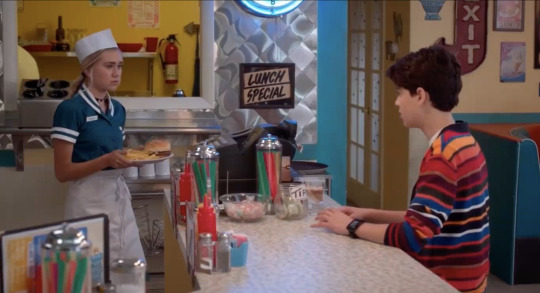
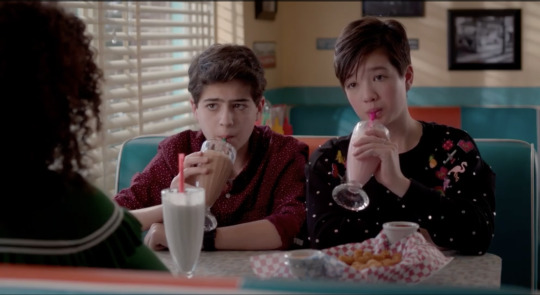
the choice to make it a very traditional 50s-style diner creates a very nostalgic, retro feel to it, which is something that's really consistent throughout the show, as you'll see. from the round stools at the bar, to the booths, to the staff uniforms, this is very obvious. the thing that i found especially interesting about it though is the choice of color. the typical 50s diner is outfitted with metallic surfaces and red accented furnishings, but the spoon is very distinctly not this.
instead, it's dressed in vibrant teal and orange, giving it a very fresh and modern take on a classic look. so it still maintains that feeling of being funky and retro, but that doesn't retract from the fact that the show is set distinctly in modern times.
of course, this could just be a one-off quirky set piece, but this idea of modernizing and novelizing "retro" things is a really common motif throughout the show. take red rooster records. i mean, it's a record shop - need i say more? it's obviously a very prominent store in shadyside, at least for the main characters, but there's no apparent reason why it is (until season 2 when bowie starts working there, and jonah starts performing there). a lot of the time, though, it functions solely as a record shop. vinyl obviously isn't the most practical or convenient way of listening to music, but it's had its resurgence in pop culture even in the real world, mostly due to its aesthetic value, so it's safe to say that it serves the same purpose in the andi mack universe.

the fringe seems to be nostalgic of a different era, specifically the Y2K/early 2000s period (because it's meant to be bex's territory and symbolic of who she used to be, and its later transformation into cloud 10 is representative of her character arc, but that's beside the point). to be honest, exactly what this store was supposed to be always confused me. it was kind of a combination party store/clothing store/makeup store/beauty parlor? i think that's sort of the point of it though, it's supposed to feel very grunge-y and chaotic (within the confines of a relatively mellow-toned show, of course), and it's supposed to act as a sort of treasure chest of little curios that both make the place interesting and allow the characters to interact with it.
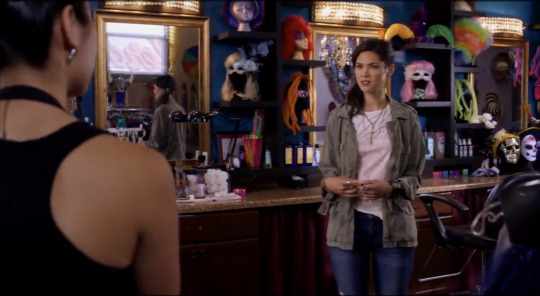
and, of course, there's andi shack. this is really the cherry on top of all of andi mack's sets, just because it's so distinctly andi. it serves such amazing narrative purpose for her (ex. the storyline where cece and ham were going to move - i really loved this because it highlights its place in the andi mack universe so well, and i'm a sucker for the paper cranes shot + i'm still salty that sadie's cranes didn't make it into the finale) and it's the perfect reflection of andi's character development because of how dynamic it is (the crafts and art supplies can get moved around or switched out, and there's always new creations visible).
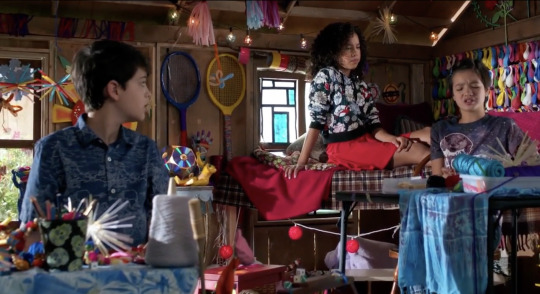
going back to the nostalgia motif though, the "shack" aspect of it always struck me as very treehouse-like. personally, whenever i think of treehouses, there's this very golden sheen of childhood about it, if that makes sense. i've always seen treehouses in media as a sort of shelter for characters' youthful innocence and idealistic memories. for example, the episode "up a tree" from good luck charlie, the episode "treehouse" from modern family, and "to all the boys 2" all use a treehouse setting as a device to explore the character's desire to hold onto their perfect image of their childhood (side note: this exact theme is actually explored in andi mack in the episode "perfect day 2.0"!). andi shack is no exception to this, but it harnesses this childhood idealism in the same way that it captures the nostalgia of the 50s in the spoon, or the early 2000s in the fringe. it's not some image of a distant past being reflected through that setting; it's very present, and very alive, because it reflects andi as she is in the given moment.
some honorable mentions of more one-off settings include the ferris wheel (from "the snorpion"), the alley art gallery (from "a walker to remember"), SAVA, the color factory (from "it's a dilemna"), and my personal favorite, the cake shop (from "that syncing feeling").
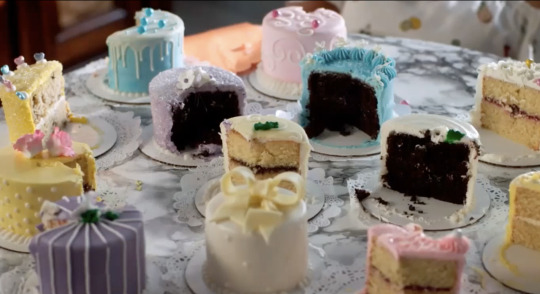
[every time i watch this episode i want to eat those cakes so bad]
these settings have less of a distinctly nostalgic feel (especially the color factory, which is a very late 2010s, instagram era setting), but they all definitely have an aura of perfection about them. andi mack is all about bright, colorful visuals, and these settings really play to that, making the andi mack universe seem really fun and inviting, and frankly very instagrammable (literally so, when it comes to the color factory!).
props, on the other hand, are probably a much less obvious tool of worldbuilding. they definitely take up less space in the frame and are generally not as noticeable (i'm sure i'll have missed a bunch that will be great examples, but i'm kind of coming up with all of this off the top of my head), but they really tie everything together.
for example, bex's box, bex's polaroid, and the old tv at the mack apartment (the tv is usually only visible in the periphery of some shots, so you might not catch it at first glance) all complement that very retro aesthetic established through the settings (especially the polaroid and the tv, because there's really no good reason that the characters would otherwise be using these).
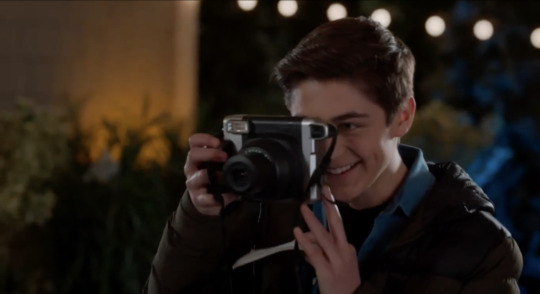
besides this, andi's artistic nature provides the perfect excuse for plenty of colorful, crafty props to amplify the visuals and the tone. obviously, as i discussed before, andi shack is the best example of this because it's filled with interesting props. but you also see bits of andi's (and other people's) crafts popping up throughout the show (ex. the tape on the fridge in the mack apartment, andi's and libby's headbands in "the new girls", walker's shoes, andi's phone case, and of course, the bracelet). not only does doing this really solidify this talent as an essential tenet of andi's character, but it also just makes the entirety of shadyside feel like an extension of andi shack. the whole town is a canvas for her crafts (or art, depending on how you want to look at it. i say it's both), and it immensely adds to shadyside's idealism. because who wouldn't want to live in a world made of andi mack's creations?

and, while it's not exactly a prop, the characters' wardrobe is undoubtedly a major influence on the show's worldbuilding. true to it's nature as a disney channel show, all of the characters are always dressed in exceptionally curated outfits of whatever the current trends are, making the show that much more visually appealing. i won't elaborate too much on this, because i could honestly write a whole other analysis on andi mack's fashion (my favorites are andi's and bex's outfits! and kudos to the costume designer(s) for creating such wonderful and in-character wardrobes!). but, i think it's a really really important aspect of how the show's universe is perceived, so it had to be touched upon.
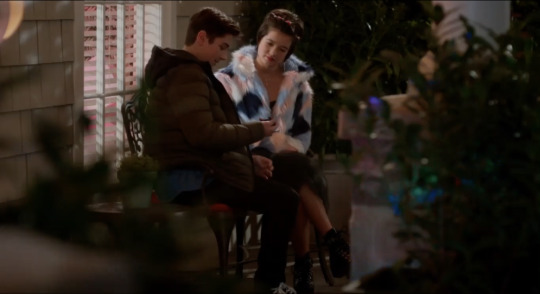
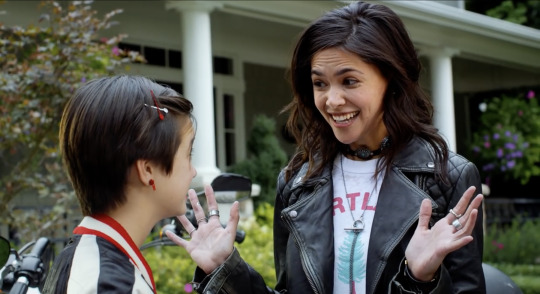
[^ some of my favorite outfits from the show! i am so obsessed with andi's jacket in the finale, and i aspire to be at bex's level of being a leather jacket bisexual]
and lastly, phones. this is a bit of an interesting case (pun intended), because the way they're used fluctuates a bit throughout the show, but i definitely noticed that at least in the first season terri minsky tried to avoid using them altogether. these efforts at distancing from modern tech really grounds the show in it's idealist, nostalgia-heavy roots, so even when the characters start using their phones more later in the show, they don't alter the viewer's impression of the andi mack universe very much.
so, what does all of this have to do with worldbuilding? in andi mack's case, because it's set in a realistic universe and not a fantasy one, a lot of what sets it apart from the real world comes down to tone. because, as much as this world is based on our own, it really does feel separate from it, like an alternate reality that's just slightly more perfect than ours, which makes all the difference. it's the idealism in color and composition in andi mack's settings that makes it so unmistakably andi mack. even the weather is always sunny and perfect (which is incredibly ironic because the town is called shadyside - yes, i am very proud of that observation).
the andi mack universe resides somewhere in this perfect medium that makes it feel like a small town in the middle of nowhere (almost like hill valley in 1955 from "back to the future"), but at the same time like an enclave within a big city (because of its proximity to so many modern, unique, and honestly very classy looking establishments). it is, essentially, an unattainable dream land that tricks you into believing it is attainable because it's just real enough.
all this to say, andi mack does an amazing job of creating of polished, perfect world for its characters. this is pretty common among disney channel and nickelodeon shows, but because most other shows tend to be filmed in a studio with three-wall sets, andi mack is really set apart from them in that it automatically feels more real and tangible. it has its quintessential recurring locations, but it has far more of them (most disney/nick shows usually only have 3-4 recurring settings), and it has a lot more one-off locations. it's also a lot more considerate when it comes to its props, so rather than the show just looking garish and aggressively trendy, it has a distinctive style that's actually appropriate to the characters and the story. overall this creates the effect of expanding the universe, making shadyside feel like it really is a part of a wider world, rather than an artificial bubble. it's idealism is, first and foremost, grounded in reality, and that provides a basis for its brilliant, creative, and relatable storytelling.
tl;dr: andi mack's sets and props give it a very retro and nostalgic tone which makes its whole universe seem super perfect and i want to live there so bad!!
#andi mack#buffy driscoll#cyrus goodman#jonah beck#tj kippen#tyrus#ambi#bex mack#analysis#film analysis#disney channel
94 notes
·
View notes
Link
The popular conception of chivalry, as a moral code guiding the behavior of honorable knights, is flat-out, laughably wrong. That’s a creation of 19th-century authors like Walter Scott, and the popular fantasy authors (basically up until George R.R. Martin) who built on their worldview in the 20th.
In reality, chivalry was all about one particular version of Guys Being Dudes. Chivalry could refer to a few different things, but the most common meaning was simply battlefield deeds, executed with some style. This, what knights referred to as “prowess,” was at the core of the broader ideology of chivalry: raw, bloody, physical performance, violence done effectively and to an agreed-upon aesthetic standard. The second major concern of chivalry, honor, grew directly out of the first. Honor wasn’t an abstract concept to medieval knights; it was a possession, a recognition of their particular status and place in the social hierarchy, which they were well within their rights to violently defend and assert through their prowess. Piety was the icing on the cake, but no knight really doubted that God approved of their actions.
An oral culture, passed around during training sessions and drinking bouts and feasts and military campaigns, produced this culture and inculcated new knights into it. A whole universe of texts, the kinds of things knights read or had read to them, sent the same message, like this 12th-century poem called Girart de Vienne:
When I see the whinnying war-steeds plunge
With worthy knights into a battle’s crush,
And see their spears and cutting blades well struck,
There is nothing on earth I love so much!
These were dudes who loved getting after it, and for them, getting after it meant blood-soaked deeds on the battlefield. It’s not that there was nothing more to it - sure, there were some bits about romance and ladies, debates about religiosity and moral actions, exhortations to do better - but the core was always physical, male violence. And it obviously wasn’t for everyone: Knights were members of a hereditary military aristocracy, and their possession of chivalry was what set them apart from dirty peasants.
Two aspects neatly parallel modern Bro Culture: first, the emphasis on physicality and the body, and how that provided both a sense of the self and secured social status; and second, the restricted, bubble-like world that produced and emphasized it, with its fictional and real heroes, its stories about great deeds, its values, and its models to be emulated. Your average knight would absolutely identify with and appreciate this impossibly toxic meathead sentiment:
Obviously, there are pieces that don’t neatly parallel, the biggest ones being the hereditary and explicitly military nature of chivalry. You don’t have to be a soldier to be a Bro, though it doesn’t hurt. And - much more important - you aren’t born into being a Bro; you become one, by doing worthy deeds of prowess.
That’s a quintessentially American value: the idea that anybody can make something of themselves if they work hard enough, move enough weight, run fast enough, practice enough to shoot a tight grouping, make the right sacrifices. The physical meritocracy (and its potential rewards of fame and fortune) is open to anyone willing to do whatever it takes to climb the ladder. Even the least intellectually gifted meathead can make something of himself if he does the workouts, takes the right gear, and builds his audience on YouTube and Instagram. Don’t forget to like and subscribe, and smash that follow button.
In a moment of stagnant social mobility, rising inequality, and incredible uncertainty around the future, this strongly visual message of self-betterment and improving one’s socioeconomic status through literal sweat can resonate deeply. It’s all within the individual’s control, if they simply work enough - an antidote to all that uncertainty, everything that’s so obviously beyond an individual’s control and reckoning, no matter how misleading and incomplete the formula actually is.
That’s especially appealing to the many millions of American men who don’t have college degrees (many more of them than women, given the gendered trends in undergraduate enrollment) who are effectively locked out of professional-managerial culture and its straightforward path into the comfortable upper-middle class. Accomplishment through physical prowess is thus a means of building both a sense of self and community.
The connections to this particular moment in American culture and history go much deeper than that, though. This whole edifice of Bro Culture grows out of the broader rise of influencers, performative self-branding through social media, and the construction of identity through consumption.
With the right protein powder, shilled by your favorite strongman, you too can deadlift 800 pounds, or at least tell yourself you’ll get there someday. With the right brand of CBD tincture, which sponsors your favorite Crossfit athlete, you won’t feel that burning pain in your rotator cuff after you clean and jerk too much weight with suboptimal technique. By religiously listening to the right Bro-approved entrepreneurship podcast, hosted by some guy who happened to get booked on the Joe Rogan Experience during a slow week, you too can buy a McMansion in an affordable suburb.
Much of what happens in Bro Culture is driven by lifestyle consumption: ads for sunglasses on Barstool Sports’ Pardon My Take podcast, brand partnerships between supplement companies and YouTube stars, tactical holsters for concealed-carry that an ex-Marine with a million Instagram followers wants you to buy. It’s self-actualization through sponsor codes.
The tactical lifestyle craze, a natural outgrowth of this particular slice of Bro Culture, is the logical endpoint of all this. It’s where entrepreneurial late capitalism and influencer trends meet imperial wars, the militarization of the police, and the emergence of Gun Guys as a default protected class within American society. You’re not a Crossfitter anymore; you’re a “tactical athlete,” doing varied types of interval, cardio, and strength training so you can be a more effective soldier or cop or firefighter or whatever, or you just want to feel like you could be one. The physical training is only part of this, since you can prominently declare your tactical affiliations with a variety of lifestyle products, ranging from coffee mugs to American flag stickers for your car to, naturally, firearms....
Just as much as its coffee, whose quality I can’t speak to, Black Rifle Coffee Company is selling the tactical lifestyle. They offer a staggering variety of T-shirts, hoodies, hats, mugs, thermoses, and stickers, many of them prominently branded with the eponymous “black rifle” of the brand. There are a lot of American flags and pieces of law-enforcement and military iconography, signifiers of the in-groups to whom the consumers of BRCC’s products belong, want to belong, or for whom they want to signal their support. BRCC has explicitly labeled itself as a coffee company for conservatives, an active participant in the culture wars. If you don’t like Starbucks and its effete, refugee-supporting, liberal tendencies, buy some Black Rifle product instead. If you like Trump, you’ll be at home with BRCC. Don Jr. endorsed them.
After the picture of Rittenhouse in the Black Rifle Coffee Company shirt appeared, its founder Evan Hafer quickly disavowed the youthful shooter. Even for an explicitly MAGA coffee company, supporting a teenaged AR enthusiast with blood on his hands was a bridge too far. But Rittenhouse had already been shaped by the world BRCC and its fellow-travelers have made. He got the message, loud and clear: You too can become a hero, or at least dress and drink coffee like one, by purchasing the right products, watching the right videos, and following the same Extended Bro Culture influencers. Don’t forget to like and subscribe.
The Veteran-owned piece of BRCC’s appeal isn’t a coincidence. They’re selling a position in the culture wars, a sense of belonging, but also a particular vision of what it means to be American, a man, and an American man. A staggering number of this part of Bro Culture’s key figures are veterans. Jocko Willink, perhaps the best known (and least openly political) of the bunch, was a Navy SEAL officer; he was actually the commanding officer of the famous sniper Chris Kyle during the Battle of Ramadi in 2006.
After retiring, Willink turned his SEAL experience into a career as a leadership consultant, motivational speaker, media personality, and energy drink salesman. His intensity, built on his military service, is legendary: His exhortations to do hard things regularly, to live by a code, and take responsibility for oneself, resonate with millions of people. And Willink is far from the only one to do so, turning overseas service in imperial wars, especially as a special forces operator, into a key component of his entrepreneurial appeal. This isn’t a judgement on his military service; it’s a statement of fact. Being an undeniable badass is a the core part of why Jocko Willink is a quintessential Bro Hero.
Imperial wars overseas always come home eventually, and they do so in complex ways. The fact that millions of people listen to Jocko Willink, buy Black Rifle Coffee Company merchandise, and dabble in more extreme fringes is a product of decades spent elevating not just military service writ large but violent combat overseas against ill-defined Others. For every Jocko Willink, there’s an Eddie Gallagher, the SEAL who was convicted of and then recently pardoned for war crimes after becoming a cause célèbre for large swathes of the online right.
If these are the heroes Bro Culture puts forth - special operators accustomed to high-intensity, high-volume fighting overseas, who then develop enormous media platforms - it’s obvious what message Kyle Rittenhouse and the innumerable police officers, tactical fitness enthusiasts, and more run-of-the-mill viewers and listeners will take. Millions of people listen to Joe Rogan when he talks to Jocko Willink, Tim Kennedy (the Green Beret and MMA fighter and increasingly open right-wing figure), or Cameron Hanes (who advocated for Eddie Gallagher’s release). They’re warriors. Joe Rogan isn’t a soldier, but he’s a black belt in Brazilian Jiu-Jitsu, a former competitive kickboxer, a bowhunter, and a firearms enthusiast. If these are the people at the core of Bro Culture, a culture that directly touches tens of millions of American men, then there are bound to be knock-on effects. If they’re constantly telling their listeners to be ready, to be tactical, to be prepared to fight and to be good at it, that means something.
This is why I think Bro Culture, or at least its extended reaches, deserve more scrutiny and attention. The code of American manhood that’s developing out of this social-media melting pot has some aspects that bear watching: A love of firearms centered on tactical usefulness (for use in what context, exactly?), a vision of muscular physicality, self-defense as a personal obligation, an unquestioning hero-worship of military culture, and far too often, a deep suspicion of people who don’t subscribe to this precise view of being a guy. Support the Troops, and if you don’t, you’re not really a man at all. If cops - quintessential subjects of Bro Culture - are told that they need to be bigger and stronger and quicker on the draw, that they’re basically Troops, and that the targets of violence deserve what they get, what’s the likely outcome of tense interactions between police and the people they’re supposed to serve?
47 notes
·
View notes
Text
The Walking Dead, “Days Gone Bye” | Analysis

The final season of The Walking Dead comes in August, so I decided to rewatch the show from the beginning as the end is nigh. TWD has been a part of me since I started to watch TV series, and I’ve watched Days Gone Bye more than seven times, so this is certainly one of the pieces of audiovisual media that I’ve consumed the most. To add a new interesting layer in my rewatches, I’ve decided to see the episodes with a critical and analytical lens, seeing it more than just as a pastime, and write my thoughts here. This will be a great ride for me, and I can’t wait to see again some iconic moments from TWD throughout the seasons and write about them.
Part 1: The World Before
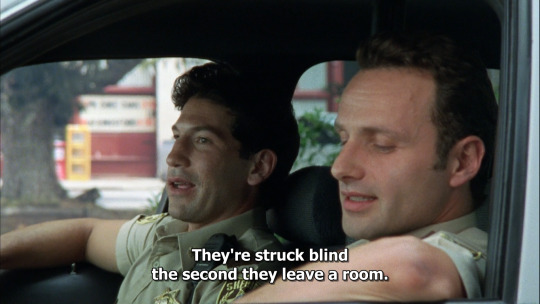
Before getting into the first act of the episode, let me talk about the teaser – the first five minutes of the episode – quickly. As this is our introduction to the world of TWD, Days Gone Bye couldn’t simply start with Rick and Shane having a chat. So it was necessary that the teaser served as a way to establish both the tone and setting of this story, and it certainly does. The teaser tells us that what we are watching is a gritty survival horror story that takes place in a post-apocalyptic world, and the teaser establishes this perfectly without no more than two lines of dialogue. It is established visually: Rick stops his car on a deserted road with no traces of civilization anywhere, then goes to an abandoned gas station where other cars are – and those cars have dead bodies inside. From there, we know right from the start that this isn’t the world we live in. When Rick sees the young girl that is in fact a walker, it is established that this is a world where the main threat are zombies. At least for some part, as in future episodes the series will show us something far more scarier than walking cannibal dead bodies is the real danger.
Now storytelling-wise, TWD already proved its value in the first five minutes. Frank Darabont directed the episode and wrote the script, and his work in the episode both as director and writter is fantastic and set the bar high if the series wanted to have a consistency of greatness in its episodes. After the perfect five minutes purely composed of visual storytelling, the first scene of the first act is dialogue-heavy and character-driven. One would think that it is to establish to us that Rick and Shane are friends, that Rick has a wife and son and that they are cop buddies, and one would be right, but it is also more than simply introduction and exposition, and that’s the beauty of the audiovisual medium as a whole.
Reading books about screenplay writing, I’ve come to know more about subtext and its applications in both movies and series. Despite this first scene doing great work in introducing us to the two main characters of the season – their mindset, persona and some backstory – it also adds so much worldbuilding-wise. Shane goes on his rant about women not switching off the lights in a house before leaving it, and Rick talks about a discussion he and Lori had earlier. See, the teaser showed us a decaying world with walking bodies. Now, the first minutes of act one show us a world where people worry about such trivialities: switching off the lights. In the tagline for the first volume of the comic book, it reads “The world we knew is gone. The world of commerce and frivolous necessity has been replaced by a world of survival and responsibility“. The scene I mentioned is basically the live-action adaptation of it. We see the world of commerce and frivolous necessity in this introduction so we can understand better and fear the world of survival and responsibility that will come later in the episode. TWD started geniously: it went from visually-driven to dialogue-driven, and after that to visually-driven storytelling, all without losing its verisimilitude and charm.
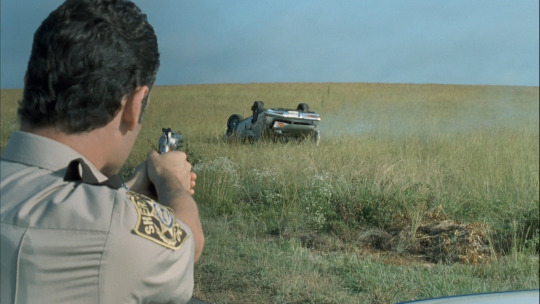
Now, something about the visuals I loved: the grainy aspect. Because this episode was shot on film – in fact, up until season ten all episodes were shot on film – the film grain is obviously visible. But instead of being just an aesthetic choice – shooting in film or digital – I think it’s also meant to have implications tone-wise. The comic books this series adapt is in black-and-white (something unusual in American comics), but it’s because the writer Robert Kirkman wanted the comic to feel like a classic George Romero zombie flick, and it worked completely. Commercially, a black-and-white TV series wouldn’t be much embraced by a large and mainstream public, but I think that Darabont solved that problem and succeeded in maintaining an aesthetic similar to the feel the comic book wanted to transmit. The excessive film grain – something that made me feel like watching a Panos Cosmatos’ movie but without the acid trips – works because it resembles the Romero zombie flicks in color, like Dawn of the Dead. It is a classical and archetypal zombie story – even if it subverts some conventions various times throughout the series – and the visuals tell us that.
Not only that, but the episode has many moments that resembled The Mist in some ways: the camera being close to its characters to make the story feel grounded and experienced by real people, the back shots to make the audience feel like they are following the characters in their journeys, the handhold camera moments that gives a documentary feel, adding a realistic perspective. All that grants a grounded vibe to the episode, which works because this is a story about how people react and live in a lawless world which can kill them at any possible moment without any warnings. It’s where chaos and anarchy reigns and where death always lurks. A story like that works better when it’s experienced through the eyes of the characters. It’s also best represented in the moment where Rick leaves the hospital and sees the sun for the first time. In the shot, the Sun is blinding us with its shining light, but then there’s a cut, and in the next shot we see only Rick covering his eyes while the blinding sun rays don’t make it to the camera. It’s the switch of subjective to objective perspective, as in the first we see the world with Rick eyes – it’s a man getting out of the dark for the first time in months – and in the second we see the same moment but from outside lens, and it showed us that this a day like any other where the sun doesn’t blind you. Besides, this episode has a low budget sensitivity – not meaning that the quality is subpar, but that it has an authenticity that is extremely convincing. It is that low budget quality that makes the story feel real in a certain way. That is, of course, until the tank in the middle of a city is shown, but even with the realism, it is still tangible, and the story continues to feel realistic in its depiction of a zombie apocalypse in the “real world”.
Not only that, but the episode has many moments that resembled The Mist in some ways: the camera being close to its characters to make the story feel grounded and experienced by real people, the back shots to make the audience feel like they are following the characters in their journeys, the handhold camera moments that gives a documentary feel, adding a realistic perspective. All that grants a grounded vibe to the episode, which works because this is a story about how people react and live in a lawless world which can kill them at any possible moment without any warnings. It’s where chaos and anarchy reigns and where death always lurks. A story like that works better when it’s experienced through the eyes of the characters. It’s also best represented in the moment where Rick leaves the hospital and sees the sun for the first time. In the shot, the Sun is blinding us with its shining light, but then there’s a cut, and in the next shot we see only Rick covering his eyes while the blinding sun rays don’t make it to the camera. It’s the switch of subjective to objective perspective, as in the first we see the world with Rick eyes – it’s a man getting out of the dark for the first time in months – and in the second we see the same moment but from outside lens, and it showed us that this a day like any other where the sun doesn’t blind you. Besides, this episode has a low budget sensitivity – not meaning that the quality is subpar, but that it has an authenticity that is extremely convincing. It is that low budget quality that makes the story feel real in a certain way. That is, of course, until the tank in the middle of a city is shown, but even with the realism, it is still tangible, and the story continues to feel realistic in its depiction of a zombie apocalypse in the “real world”.
The whole sequence of the car chase and the shooting between the cops and the criminals is beautifully conducted by Darabont, who knows his craft remarkably and executes it in a manner like no one else does. The memorable shots, shot by Darabont, immortalize the whole sequence and reach its climax – the gunshot Rick suffers – perfectly in a crescendo that works better here than in the comics, this being an easy task, but still, Darabont managed to do it in an impressive way, totally deserving a bravado status.
Also, something that I also appreciated, and I think it’s overlooked: when the police cruiser where Rick and Shane are passes through a road, we see a single crow eating a roadkill. What do this mean exactly? Animals can’t turn to zombies so one might think this is only a moment with no meaning behind it. But now I interprete it as a symbol. It is meant to represent that society has be decaying long before the dead came to eat the living. It remembers me the first Mad Max, where the world is not in the same level as it appears in Mad Max 2: Road Warrior – a full-on post-apocalyptic society – but it is in its final stages, leaning to barbarism and uncontrollable chaos. The producers of TWD announced an anthology spin-off series named Tales of the Walking Dead, and it certainly would be interesting to see more of the transition between our world and the post-apocalyptic zombie-ridden world, showing the process in-between of transformation and decay.
Part 2: Brave New World

The second act starts as Rick steps out of the hospital and faces the current reality of his world, and it’s an ugly one. Rick sees dead bodies everywhere and discarded military gear. Something dreadful happened when he was in a coma. The world undergone a change so great in his sleep that it’s impressive that Rick didn’t drown in total madness when he first saw what’s left of society. Most of act two is about Rick having to come to terms with his new life: one entirely ruled by survival. Now, another interesting element that is also a symbol in my interpretation: the bicycle girl. The bicycle girl (which is the zombie without its lower body) is the first walker Rick encounters. He is scared by her and runs away from her with the bicycle that was there next to him. The bicycle girl is nothing more than the remains of the past life of Rick and the world before. It is dead and alive at the same time – like the walkers – but in a pitiful state. It can’t be on its feet and is always trying to grasp and touch Rick, but, ultimately, it can’t. Rick fears it, and because of that he runs.
Most of the second act is focused on the interactions of Rick and Morgan Jones. Morgan, after encountering Rick and saving him from a nearby walker, takes him inside his house, but fearing that the gunshot wound was in fact a walker bite, Morgan rightly tied Rick to a bed and waited for him to wake up to ask some questions. Now, it’s incredible how this episode never misses a beat and is not made of only three truly great scenes, but all of the scenes are great. The whole dinamic of Morgan explaining to Rick what happened and what it takes to live in this new world felt so natural that no critic could say it was bad exposition. It was exposition done right, revealing more about Morgan’s character, showing him as a good man and a father to his son Duane. It’s easy to understand why Rick and Morgan liked each other one day after meeting for the first time. The chemistry is real, and it’s unbelievable how seasons later, when they see each other again, the chemistry is still there.
Andrew Lincoln and Lennie James are spectacular actors. Their acting in this episode is astonishingly extraordinary. I’m pissed that they didn’t won any awards for it, they certainly deserve it. Andrew’s acting was great all way through, but when he first arrives at his house and cries for Lori and Carl you could feel the man’s pain and suffering. One moment that is perfect and maybe one of the bests of all TV history is when Rick is having an existential crisis. “Is this real? Am I here?”, asks Rick while facing the ground. It’s such a powerful reaction to the absurdity he is experiencing and it feels so damn real because Andrew Lincoln can cry like a pro and give the gaze of a man that is lost. Rick is lost. And this scene can provide such a powerful punch to the audience that you can’t help but be already invested in Rick’s journey. He just wants his family, so he can put some sense in a mad world. Without them, Rick is lost.

The second act makes us empathize more with Rick and Morgan. They both have admirable goals. They just want to live and provide for their family. Their bond is developed exceptionally in their final moments together – before Rick travels to Atlanta – that you are left caring for them and wanting a reunion. The final scenes of act two were made to make you feel emotional without doubt, and I’m sure that it worked on some people and made them fall in love with the series instantly. It’s when Rick kills bicycle girl and Morgan fails to kill his dead wife, now a walker. The soundtrack by Bear McCreary is phenomenal and adds so much dramatic and emotional weight to the scenes, and it fits perfectly with the tone of pretty much the core of the series. It’s a haunting song, a sorrowful one full of melancholy, but it also has a spark of hope in it. It makes a statement: everything is sadly collapsing around us, but there’s still hope of rebuilding. The Mercy of the Living is TWD summarized in an orchestral piece, and I feel like crying every time I listen to it, just like the piece Alive Inside of Telltale’s game, that also does a masterful job in creating a sad but hopeful atmosphere in its melody. The bicycle girl – which is the past Rick and the world before – must be killed by Rick if he wants to continue his voyage, to which destination is his family. Rick is teary and heartbroken in killing bicycle girl because now he has to fully embrace a life ruled by survival. “I’m sorry this happened to you.” is Rick final message and requiem to the world and consequently to his past self – a quiet Rick that didn’t want to discuss with Lori in front of Carl –, both who had problems that they couldn’t resolve before the tragedy that hit them.
Part 3: The Beginning

The third and last act are in fact the beginning. We saw a peak of a world before the zombie apocalypse and Rick waking up in this desolated society in the first two acts, but the third one is to introduce and set up what the series is about and what will do to its end: show the characters in a battle for survival, and ultimately in a quest for the return of humanity and civilization. Both are depicted in the scenes where Rick is trying to save himself from a horde of walkers that attack him and his horse, and the other with Shane’s group listening and trying to talk in the radio with a mysterious survivor (Rick himself) who warns about his coming into the city, showing their efforts to help fellow survivors who might enter Atlanta without knowing its dangers, thus demonstrating that they are still human after all.
The episode show us a little about the relationship of Shane and Lori, as well as a glimpse to their group. It wasn’t exactly necessary, but it doesn’t hurt in any way the season’s progress and development. The third act is best represented by Rick entering Atlanta and having to escape a humongous horde of walkers. Rick manages to survive by hiding in the tank that was parked in a street. The scene also show us that zombies had some intelligence – they crawl and try to open things – and some of them look cartoonishly green or grey, instead of the realistic putrid rotting flesh look the marvelous make-up by Greg Nicotero can provide. And both of these things are common to the iconography Romero made for the zombies. It’s very clear that Darabont takes inspirations from his movies and respect their legacy by expanding it to a new range of people and an audience that is maybe not that familiar with Romero – I wasn’t when I first watched TWD and when I saw Romero’s movies I was impressed by how it influenced the series.
Days Gone Bye is a masterclass of how a pilot should be made. This quintessential pilot introduces a storyline that will be finished within the episode. while also setting up what’s coming next in the season, laying ground for all the future episodes in the best way possible. It introduces a protagonist that proves that he can sustain a show on his own – he is a caring father, loving husband, a good man and a kind of Western hero, we see him riding in his horse towards the imminent danger full of guns and determination searching only for his family. The Walking Dead may not be recognized as a TV series that revolutionized the medium, but it revolutionized its genre, and overall it is a great series that deserves recognition, and so does Days Gone Bye. It is simply the perfect pilot.
10 notes
·
View notes
Text
I forgot to watch content all week so i wrote about games ive been playing
9/2/2021: The Truman Show
You should fear your fears but embrace them and use them to guide you into the unknown, to explore and experience what life has to offer. Fear stands between you and the fullest experience of life so you must pass through it to better yourself. Heed not the walls built about you and the chains made to hold you. Though the architects insist it will preserve your life, containment is anathema to life. Do not take in faith the benevolence of powers that be; instead trust those who would support and liberate you, guide you through fear and into life.
As best I can lay it out, I think this is the philosophy of the Truman show but there is so much more to read into it also. There is critique of systems of commodification and celebrity (i.e. capitalism) reducing human beings to a consumable good as well as encouragement to find and pursue your goals despite adversity and even sensibility which is also tied to the illusion of economic responsibility. You can’t put a camera inside a human head, you can never “know” them without being an active and intrinsic part of their life, but also there is need for reciprocation. If one half exists with ulterior motive then the entire relationship is rotten; sincere humanity is what creates real connections. Without such your world is fake. A world built around one person is a world where no one can truly live. All these actors have given up basically their entire lives for the sake of watching Truman have his life built around him by outside forces, have allowed themselves to be commodified and dehumanised for the good of one man, Christoph. The man at the top has delusions of grandeur and thinks only of his own bottom line, he cares not for his subjects but simply wants them to do as he tells them because it benefits him to commodify their lives and interactions. Even then he cannot stand to lose control and in seeking to demonstrate Truman’s “realness” he structures his life so thoroughly that eventually there’s no reality left, only a script and adverts. But the people watching still empathise with Truman because everyone in the working class understands what it is to be trapped because real life is our own Truman show and one day we must all pass through fear, step out of the dome and create a real life for ourselves outside of the system of commodification which consumes everyone’s life and removes all realness and sincerity and emotional catharsis from it.
I unreservedly love this film.
14/2/2021: Assorted Game Reviews
Horizon Zero Dawn (Unfinished due to technical issues, 45 hours inc. parts of Frozen Wilds):
This game is really cool and really fun. I think it is defined by its incredible setting which somehow creates a fresh feeling post-apocalyptic environment. Said environment creates intriguing alt-future lore and some very interesting environments to explore. I love the machine designs (especially tallnecks!) and was very sad to hear one of their contributing artists passed away recently but I’m glad their work lives on in this visually stunning game. I’m a sucker for Ubisoft-style open world games simply because it tickles a certain kind of itch and somehow this non-Ubisoft game has outdone Ubisoft on their own formula, which is hilarious, but also good for me as running around this world exploring and clearing map markers is engaging fun. Not least because of the combat. I have a minor criticism here that the combat feels slightly awkward on mouse and keyboard, the arrows never seem to go where I’m aiming, but aside from that the experience of fighting is a grand one. Enemies never lose their threat and I love the weak spot system the game employs which makes every tool useful in niche circumstance and rewards curiosity. It specifically manages this in a way that I feel the Witcher series could learn from if it ever returns; by making head on assault less viable and encouraging tactical hunting. I do feel this system makes hunting robots so fun that by contrast hunting humans becomes a chore however, though I noted this improves in the dlc with the addition of humans with elemental weaknesses limited in number as they are. I cannot speak for the story in entirety but what I encountered was pretty good, though I feel as if it was only just really getting going at the point where I could not continue. I find Aloy to be a compelling and well portrayed protagonist and though I can guess about her origin and the ultimate end of the alt-future apocalypse I still want to see how it plays out on screen, so will return to this as soon as I’ve fixed it.
Rimworld (122 hours. Familiar with but do not own Royalty Expansion):
Rimworld is one of those super special games that I don’t think I have a single problem with. Fair warning it can be brutal and is heavily dependent on RNG but this allows it to create truly unique and interesting scenarios on a constant basis. In the wider perspective it could be described as formulaic, with regular cycles of managing the settlement between raids and random events, but the devils in the details. Colonist traits, health and skills dictate how you play and sometimes you’ll be forced to adapt as some colonists simply refuse to perform some tasks. The depth of health particularly amuses me, in that each little part of someone’s body is modelled in a way. If you’re in a firefight you may take a single bullet which grazes your finger and you’re fine. Alternately it could pierce your human leather cowboy hat, your skull and kill you instantly and the game will tell you exactly what happened. The risk/reward element is addictive enough, and that’s without accounting for just how cool it is to see your colony slowly expand. Establishing more and more options for crafting is fun and shows off the full range of different items in the game which is fucking extensive. Between clothing, weapons, armour, sculpture and drugs to name only a few you have the opportunity to create many varied production lines either for your colonists or to trade for money and there is a lot of fun to be had here as well as it is quite satisfying to see psychoid you have grown personally become the cocaine your colonists snort to help them stay awake on limited sleep. From an archaeologist’s perspective it is especially cool to look back over your base and see the hints of how and why structures were built and remember the history of your limitations and development through structure. I think the lore of the universe is really cool too, a very 40k-esque kind of place except with far less order, somehow. But the universe does an excellent job of feeling alive and moving constantly on both a planetary and interstellar level. You can fully believe that while you build wooden shacks to shield yourself from terrifyingly low temperatures there are simultaneously rich pieces of shit living it up on the glitterworld that’s one system over. The music does an excellent job of creating the wild west frontier atmosphere the game cultivates to great effect. Ultimately, for just being a grid with a series of different numbers attached, this game does a fantastic job of creating a compelling, brutal and very real colony management experience. I dont think I can properly put into words the grandness and scope of this one. I didnt even mention the modding scene, which is expansive and tailors to basically any need you could have. The Rim is a terrifying place but theres so much fun to be had.
Factorio (86 hours, mostly 1.1):
Having completed a game of Factorio I can tell you reliably that this is one of the best games ever made, thoroughly addictive and fun. If you like numbers, logistics, TRAINS, its gonna be your thing. Not to mention its probably the only documented case of a game with no bugs (so far as official forums are concerned). Strictly speaking this games combat is not the most engrossing thing but good lord do you feel it when you acquire a flamethrower. The way each aspect of the game (production, research, logistics, combat, upgrades for everything therein) feeds into the next is a really well constructed balancing act such that you must experience the full game in order to complete it and I always appreciate this kind of design. I think its one of the best tenets of factory game design especially as its something present in Satisfactory too. Beyond all of this generalised good the game is also excellent in its intricacies, the architecture necessary to build a maximum efficiency base, the level of planning and organisation that can be employed is mind-blowing. Not to mention the mod community, factorion is already an extensive experience and some mad bastards have seen fit to complicate it further, hats off to them. This really is a great moment in gaming.
Destiny 2 (198 hours, all expansions, played some post Forsaken release, mostly Season of Arrivals onwards, spent roughly £20 on microtransactions):
This is a very interesting and enjoyable experience, but I must say it can be a bit controversial at times. What its does particularly well is moment to moment gameplay and design in all aspects. The game is stunning; between environments, cosmetics, shaders ships and ghosts there’s a vast range of incredible things to see, all rooted in the “pseudo-magi-science” aesthetic it’s got going on. The class design is excellent and you really do feel like you embody this rampaging madman / agile gunman / space wizard archetype, whichever you choose to play. The abilities, especially supers, are very satisfying. Everything has heft and power behind it which can be felt in all aspects of design; sound and animation is top notch. Movement is cool, you can feel how fast you move both on foot and in vehicles and the navigation has a little fun subtlety depending on your class jump, even if you can bounce unpredictably occasionally. But for the love of god why is the wall kick in there? It has only ever served to push me from a ledge into a bottomless pit. You're looking to remove antiquated content? Start there. Some guns are not so good to shoot but there’s such a great range of guns that are fun its like complaining about one drop in an ocean; and enemies are fun to shoot at, each faction distinct in meaningful ways and presenting an effective challenge. Speaking of oceans, that’s one way to describe the lore. I haven’t dived too deep but it keeps going down forever and everything I’ve read is intriguing. As a former Elder Scrolls lore nut this is something I could definitely sink my teeth into, though its much more of a pulpy sci-fi vibe than a pure nonsense vibe. I do think the game has a bit of a loot problem, primarily in regards to the conflict between high stats and looking good. This should never be a conflict, and yes you can apply ornaments to any purple gear but that’s not enough when I spend the entire time grinding power levels and thus must change armour and weapons on a constant basis to progress. This game needs a true transmog system and if not that, rethink how gear power level works. Perhaps rather than earning new instances of gear you always possess a version of it and the loot you acquire in missions just upgrades your instance to your current overall power level? This would serve to do away with the current upgrade system which I think is a needless additional grind. Perhaps it could be retained in using enhancement cores to empower gear as present but necessitating a whole upgrade module to keep your favourite weapon on hand is kind of painful honestly. There is also at present the issue of sunsetting gear, mildly controversial to say the least. If it’s necessary to streamline the game and make it function moving forward so be it but surely loot pools should be adjusted so you can actually get useful loot from older locations? And why sunset personal instances of gear which can be acquired at the regular power level anyway? I had to throw away my favourite bow and hunt down a new version of the exact same weapon for… what reason? I do think destination navigation leaves a little to be desired also. I get that having a physical hub world is meaningful but Destiny does not have a very extroverted community; I can count the times someone noticed me in the tower on one hand. And its not even like there’s fun activities to be found in the same sense as say Deep Rock Galactic, which really does take advantage of its hub. Perhaps for players who simply want to go about their business all of the vendors could be set into a menu system where just clicking an icon takes you to their menu from anywhere in the system rather than, per se, having to go through an entire loading screen (Which takes you to orbit and back) to reach a location which serves simply as the front for four menus. These are established player problems. As a dedicated PvE player I can say that this game is immensely fun in combat and growing in power does feel really good. It’s something I recommend getting into, there’s just some very large creases that need ironing which the Bungie should really take the time to address rather than pushing out new in game content every three months.
#the truman show#horizon zero dawn#rimworld#factorio#destiny 2#d2#film#movies#video games#i dont know what im doing#hzd#opinion
17 notes
·
View notes
Text
Optical Illusions: A Study of Aesthetics in Activism in Two Accounts
There’s been a particular thing bothering me about social media for a while. I should probably get a cool editing app, write it in a few bullet points and post it on Instagram. You know what I’m talking about, right? The goddamn infographics. If I have to sit through another slideshow explaining to me another military conflict, another societal issue, another existential unfairness on a baby pink background in a cheery font, I might combust. But the cognitive dissonance of aesthetics in activism has been a problem for a while, hasn’t it? So today, I want to examine the effect of focusing on aesthetics over content, or, on the flipside, not considering the optics of your activism enough, and what it does to the consumer of your content by picking apart two local activist-adjacent media projects, Tetraedras and Giljožinios.
Firstly, I want to make my own bias abundantly clear. I am personally acquainted with the teams of both projects, so obviously there will be innate personal bias involved. I highly encourage anyone reading to check both projects out themselves (@t3traedras and @giljozinios on Instagram, as well as Giljožinios’ YouTube channel) and make their own conclusions on the matter. I believe that while my familiarity breeds deeper knowledge of my subjects, it also makes me more vulnerable to assumptions about individuals involved. My insights come from the perspective of an observer, not an expert. Welcome to the circus.
The use of the word “optics” in a metaphorical political sense sprung up in the 1970s to describe the way major political decisions would not necessarily affect an average citizen, but how it would appear to them, e.g. 'U.S. President Barack Obama temporized for weeks, worrying about the optics of waging war in another Arab state after the Iraq fiasco' (Toronto Star, 19th March 2011). However, it’s become increasingly relevant in our age of social media, an age of perceptions over substance, of shortening attention spans and increased barrage of information one has to stomach daily. Social media is the great equalizer - a random person off the street can theoretically hold as much influence as a politician - thus it is becoming increasingly crucial for the average Joe posting on the countless apps owned by Facebook to be as familiar with PR terms as a firm with a six figure salary. Or at least that would be nice, seeing that more and more average Joes are becoming actively involved in politics and education, seeking to influence their newfound audience.
So, let’s see how successful average people with no media or politics degrees are at balancing their image. Both Tetraedras and Giljožinios lean into their 2010’s social media project optics: millennial pink themes, bold names, young teams. But that’s where the similarities end. Tetraedras’ brand is safety. The shades of color on the profile are calming, the illustrations are youthful and playful, their more serious posts are interspersed with more relaxing content (poetry, photoshoots, etc.). Giljožinios is confrontational. The colors electric, posts loud and to the point, they’re what it says on the box - a leftist project - and unapologetic about it. This might help to explain why audiences react as differently as they do to these two, on the surface, similar accounts. Because while you might’ve stumbled on Tetraedras organically while browsing, them having almost two thousand followers, Giljožinios crashed into the educational/political social media scene by being featured on the goddamn national news, that’s how controversial the project is. And obviously I am oversimplifying the issue, Tetraedras slowly built up to posting more opinionated content, while Giljožinios came in guns blazing accusing USA of imperialism, but you’ll have to let me explain. Tetraedras, in its essence, is a welcoming environment. They explain complicated problems in short bullet points with accompanying comforting visuals, their mascot is a inoffensive geometrical figure and their face is a beautiful girl, make-up matching the theme of the post. Giljožinios is named after a revolutionary device, their profile picture is a monarch being beheaded, their host quite infamously sat in front of Che Guevara memorabilia in their first and (as of writing) only video. It’s a lightning rod for angry comments by baby boomers, no matter what comes out of their mouth. In fact, I would argue that, if presented accordingly, the idea that the US is conducting a kind of modern imperialism is just a simple fact and personally can’t wait until Tetraedras posts that with a quirky illustration of Joe Biden to introduce the concept to the wider public.
This leads me to my next point, because despite what’s been previously suggested, I’m not here to solely sing Giljožinios’ praise. There is a cognitive dissonance in both of these flavors of social media activism, but while I can understand Tetraedras’ on a PR level, I’m kind of personally insulted by Giljožinios’. While purely personally I find aspects of Giljožinios’ radicalism distasteful, I appreciate the honesty in the youthful maximalism, of coming in strong and not backing down, but from the guys that made a communist Christmas tree once I almost expected something more stirring than “military industrial complex bad”. This leads me to ask: who is your content for? Your average breadtube-savvy twenty-something already heard this a thousand times, because they consume similar english-speaking content and I doubt any minds of the vatniks that came by to fume in the comment section are being changed. I’m obviously harking on a newborn project here, the team of which has already been bitten by authorities censoring their content, but so far there has been a lot of optical bark, but no substantial bite, especially considering the team seems to be in a safer place now. And the inverse is true for Tetraedras, while I can understand wanting to be visually interesting yet inoffensive, their visuals are sometimes laughably, morbidly light for the topics they discuss Sexily posing in Britney Spears-inspired outfits while discussing the horrors of her conservatorship springs to mind (funny how Britney’s conservatorship leads her to have next to none bodily autonomy, including her public costume choices). And, once again, your target audience is teenagers. They understand English, they’ve seen the news, they don’t need you to translate infographics filled with statistics and information that’s locally completely irrelevant. There needs to be some kind of middle ground between aesthetic cohesion and common sense, because this all signals to the viewer that the content is meant to be mindlessly consumed first and to educate second.
Which leads me to ponder what kind of consumption accounts like these encourage, which will surely lead me to an early grave as I drink away the existential dread of how social media rots all of our brains. Because yes, actually, producing funky visuals to convey an idea way too complicated for an Instagram post is fun. I myself got distracted multiple times during writing to make the first slide for my own post. Meta, I know. This is obviously more of a problem for Tetraedras, who seem to fervently resist injecting their content with a few more paragraphs and a tad more nuance, but even with Giljožinios choosing a more appropriate long-form format to educate, I still pray everyday they don’t get lost in the revolutionary reputation their group built up and forget to make a point, not just talking points.
Because what all this all inevitably leads to is misinforming the public. Again, this seems to be less of a problem for Giljožinios, as the amount of critical eyeballs they have on them leads to them being corrected on every incorrect numerical figure and grammatical mistake, I just hope all this harassment, once again, doesn’t get them all caught up in the optics of a revolution against all the Facebook boomers and forgetting to do their due diligence to the truth. As far as I know, the only factual mistake is miscalculating how much Lituania invests in NATO and there’s still a historical debate in their comment section about the existence of a CIA prison in Lithuania, if anyone’s concerned. Tetraedras, however, is safe. And safe content goes down just like a sugar-coated pill, you don’t even feel the need to fact-check it. And fact-checking is what it sorely requires, or else you’re left with implying that boxing causes men to become rapists and citing statistics of every country except the one in which, you know, me, the team and the absolute majority of their followers live in.
So what’s my goddamn point? Burn your phone and go live in the woods, always. But in the context of this essay, if you are a content creator that aims to educate, inform, incite, whatever, you need to put aesthetics on the backburner. And, more importantly, we as consumers need to stop tolerating content that puts being either pretty or inflammatory first instead of whatever message it’s trying to send, because the supply follows where the demand goes. Read books, watch long-form content made by experts, not teenagers on the internet chasing followers out of not even malicious intent, but almost a knee-jerk reaction. Because while the story of those two accounts cuts especially deep, expectations for local-, even friend-made content being much higher than that for some corporate accounts shooting their shot at activism, the problem is entrenched deep, thousands of accounts exhibiting the same problems racking up millions upon millions of followers. Having said that, my attention span is barely long enough to read the essays I write myself, so maybe do burn your phone and go live in the woods.
Also, pink is actually my brand so both of these accounts are being contacted by my lawyers and the rest of you don’t try any shit.
3 notes
·
View notes
Text
StEx Appreciation Month, Day 31: Nitpicks
SO, I have a LOT of nitpicks about literally every aspect of the show, like I could go on and on, but then this post would be the embodiment of this gif:

So for today I’m just going to focus on costume nitpicks! Like with everything in the show I have an ideal version of everyone’s costume/wig/makeup, so today I’ll just go over my main nitpicks with the various costumes and post my favorite versions!
Obligatory JapanAus picture because those tours overall had the BEST costume aesthetics.

Let’s get started:
(Also just to go ahead and get this out of the way, this post is almost completely ignoring the 2018 redesigns, like. Those don’t live in my head. I’ll just be focusing on the Broadway/Bochum/tour designs.)
Rusty:
Okay so with Rusty my main nitpick is!!! That stupid empty black space that’s above his chest plate in SO many of the costumes!! Like WHY is that there?! Here’s a good picture of it:
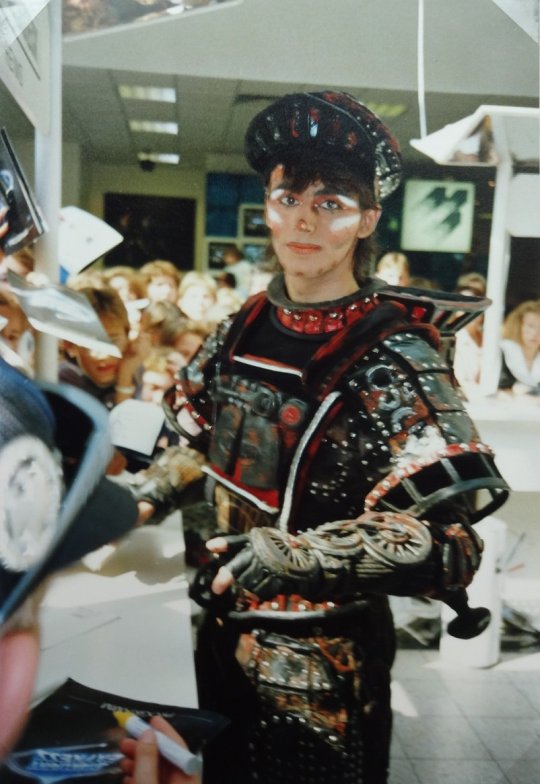
It drives me absolutely insane aljsldf. Luckily Bochum eventually corrected this but that it was ever there drives me up a wall.
Another nitpick is his headband… I can tolerate it when it’s paired with the hat, but I can’t stand it on its own, it just looks ugly to me. And speaking of his hat, I love most versions of it, EXCEPT for the New Starlight Express one where it was styled after a baseball cap. That bothers me on a level I don’t even fully understand alsjflds.
Anyway, I think overall my favorite version of Rusty’s costume is the 2018 version… I think the silhouette looks strange, especially from the side, like kind of too baggy? But overall it’s really cute, I love the colors and the new chest plate design, and the HAT. Also really like the new makeup!! It was looking rough for a minute lmao.
This is Peak Performance (not the Pearl…definitely not the Pearl):

Pearl:
Being as I’m in love with most of Pearl’s costumes I actually don’t have a ton of nitpicks. I think my main one is that I’m not a fan of the salmon/gold tones that were sometimes used for the bodice. For example:

I think moreso than the costumes I’m critical of Pearl’s wigs. I HATE when she has straight wigs… the only exception to this rule is Stephanie Lawrence’s and Nikki Belsher’s because those wigs were also big and fluffy. But that lanky thing Bochum had in the early 2000s? Terrible. Pearl should have big, dramatic curls. Also, this should go without saying but her hair should be PINK. Blonde Pearl actually gives me acid reflux.
Also I don’t think much attention is given to her headpiece, but I really love when they’re big and princess-y. Like, this headpiece with these earrings? I love:
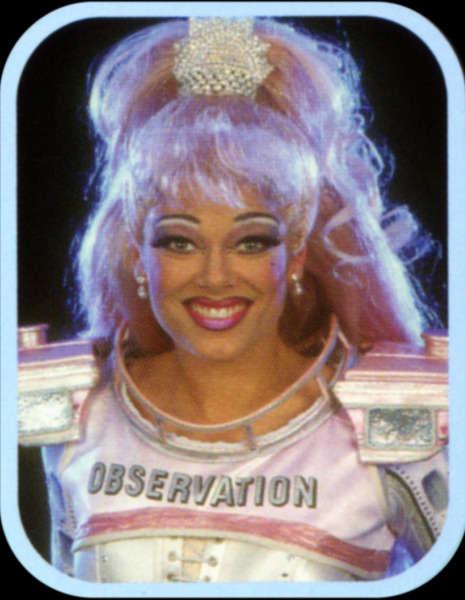
As far as a favorite Pearl costume, that’s really hard because I love so many of them, but I’ll say this one. I think it’s a nice balance of pink and white:

Greaseball:
I don’t have a ton of nitpicks about Greaseball’s costume… like, it fucks pretty hard? I moreso have beef with his makeup. NONE of these men know how to blend and it looks terrible. I get that it might be a stage makeup thing that looks better under stage lights but I still don’t even really buy that because every other character blends?? Also, I don’t like how the makeup is just contouring… I get that it’s to make the actors look more masculine, which does suit Greaseball’s character, but PLEASE give that diesel some character makeup!!
I really stan the Broadway makeup for this reason. Look at this Jareth-looking bitch, he looks amazing! And it’s just SO cool:
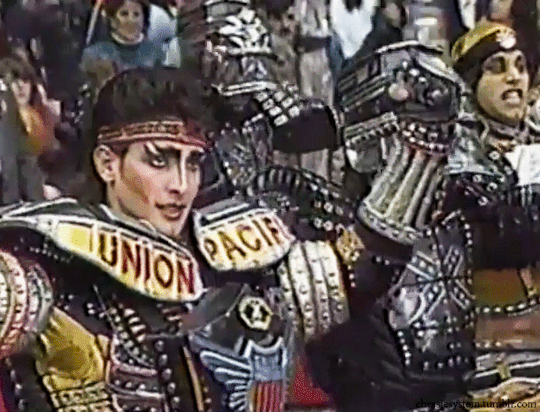
Idk even this London makeup is pretty okay imo… anything to make him more visually interesting 😭:

Dinah:
My main gripe with Dinah’s costume will forever and always be the apron lmao. I’m very, very picky about it because it’s SO easy to make look tacky as hell. The 2018 apron is the ugliest its ever been, I’m sorry:
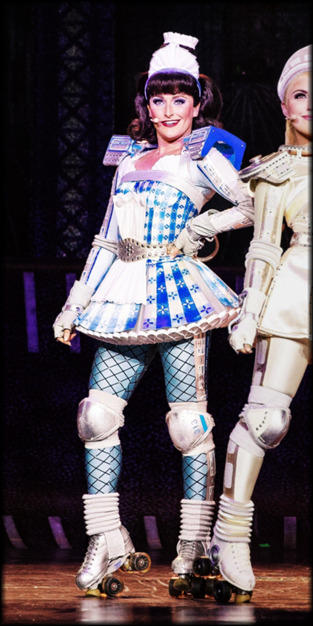
LIKE WHY IS IT SO BIG AND LONG. Also the silver strap around her chest is WAY too high now. I swear they tried to make the 2018 coaches more modest in the ugliest ways possible. But anyway.
I prefer for the apron to only be beneath the belt, but if it also has to be above the belt I can tolerate it if its small, like the Broadway design or the earlier Bochum designs. I also prefer when her leggings are on the more silver/metallic side than just straight up blue. Broadway and Japan-Australia had the right idea with how metallic they made everyone look.
As far as Bochum goes, I feel like the costume’s peak was from like 1997 to 2007:

PERSONALLY, though, my ideal Dinah costume would be Debbie Wake’s from the Japan tours. The color, the leggings, the wig, it’s all so… Peak! I also really love how the top of her skirt is divided into sections?? It’s really cute. The only thing I’d change is I’d remove the part of the apron that reaches above the belt and adjust the color of her wig. But otherwise I love this one so much 🥺🥺🥺:
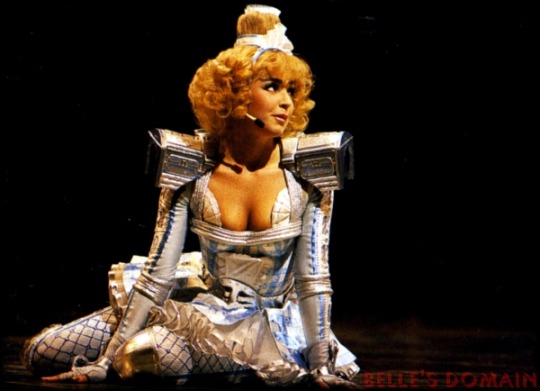
Electra:
I have a lot of very disjointed thoughts on Electra’s costume, but bottom line is I’m rarely content with it… but my MAIN nitpick is definitely the color scheme. I know that it’s intended to be blue/red/silver but instead it often looks blue/red/white to me and I just CANNOT dissociate that from the American flag/overzealous patriotism alsjdlf, it kind of gives me heartburn. I’ve seen some fan redesigns of the costume that incorporate a blue/red/gold color scheme instead and I think that could REALLY fuck, though I don’t know how it’d translate to the stage/irl. Or just?? Design his palette after the bi flag colors??
Another nitpick is how boxy and bulky his chest box often is. I feel like I can’t criticize this TOO harshly because, in my opinion, this musical should be FIRMLY 80s, and that’s probably what counted as “futuristic” in the 80s, but it’s just a personal preference of mine that I wish his chest piece was more slender and streamlined. I think it’d make the silhouette better and just?? Look better??
I also don’t like most of the mohawk wigs… they just look… VERY cheap and fake to me most of the time. I prefer the looser/wilder wigs because they look softer and more natural.
ANYWAY I’ve found that the costume that actually sates most of these complaints for me is the Japan-Australia costume. The palette actually looks blue, red, and SILVER to me, and the body suit is just?? Sooo shiny and metallic and sparkly?? It’s so pretty. The wig is a perfect balance of the looser/wilder London wigs and the early mohawk wigs, and the MAKEUP is so good, it’s the only time I’ve seen a silvery/metallic base on Electra work and NOT whitewash the fuck out of the actor. Not to mention the base in JapanAus matched the body suit REALLY well and aaaah idk I could wax poetic about this costume all night aljsfld it’s really good and I appreciate it for being the, like, one (1) Electra costume I vibe with 😭.
Again, I’d streamline the chest box if I could but overall? This is peak performance:
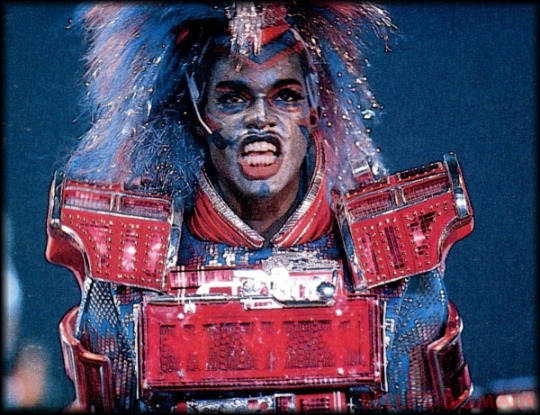
CB:
Off the bat I’ll say I hate how big his shoulder boxes have gotten over the years. Like they are just ridiculously massive, it looks kind of awkward when the actors can’t even rest their arms by their sides due to it. They look like little kids wearing arm floats. Also not a fan of how much lower the neckline has gotten, and how much smaller the bandana has gotten?? His chest and neck are SO exposed now when they use to be completely covered and it irks the hell out of me.
Funnily, this one picture pretty clearly displays all three of these nitpicks:

Compare this to back when the neckline was higher/the bandana larger, he’s completely covered. He also isn’t fucking DROWNING in his shoulder boxes:
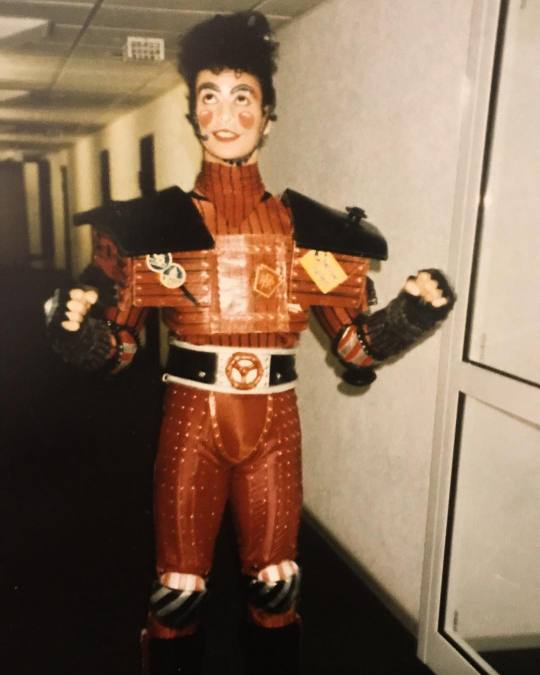
Also not a fan of the hair piece Bochum has used in recent years. Like it was just so much cuter when the actors used their real hair :^//. And I just Do Not Vibe with how straight and neat the hair piece is, CB has wild, curly hair and I’ll die on that hill.
ALSO, and this is more specific to just one actor, but I kind of hate Dan Ellison’s makeup aljsldf. Like it’s well done but it just has far too much going on. All what CB needs done is his cheeks, his eyes, and his lips— all that extra that Dan does on his jawline and with the laugh lines around his mouth and eyes is just… too much. And it frustrates me so much because he would be SO much cuter if he went with a simpler makeup!! Ugh. But anyway.
This was 100% the makeup at its best, like. Absolutely peak, thank you Thierry Gondet:

And my favorite costume comes from the 1990 Japan tour. I ADORE how this chest box is fitted and designed, and it just looks so shiny and red? Like it was freshly washed and painted 😭. Not to mention the red contour on his temples is kind of a Look:
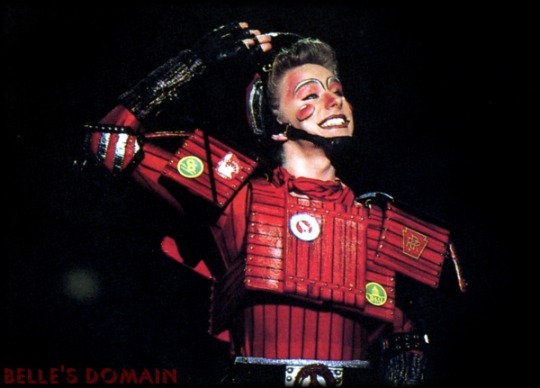
The only thing I’d adjust is I’d give him the suspenders present in most of his costumes, because they’re honestly adorable. And, of course, he needs his Chessie System sticker. But otherwise? This is Peak Performance.
Okay I was gonna do more but this thing is fuckoff long as it is, so I’ll just stick to the Big Six. If you made it this far you’re a trooper, thank you for taking the time to read my ramblings aljsldfs.
#stex appreciation month#starlight express#stex rusty#stex pearl#stex greaseball#stex dinah#stex electra#stex cb#naph.txt#THIS IS SO LONG ALJKSLFDS I'M SORRY
31 notes
·
View notes
Text
Jack's End of Year Video Game Round-up.
There were many things I couldn't do this year, being in lockdown and all, which in turn meant I played a hell of a lot more video games than I normally do. Here's a quick rundown of what I thought of them.
Hitman 2
IO have sort of perfected the Hitman formula now, so future entries in the series simply have to ask the question of what new directions you can take that formula. In that regard Hitman 2 is a resounding success, setting sneaking and assassination in scenarios around the world from race tracks to holiday resorts, and thus making it the best entry yet. It's possible one day the Hitman conceit will wear thin, but today is not that day.
Thronebreaker
Most people will go into Thronebreaker just wanting a stand-alone version of the Gwent we played during Witcher 3. Thronebreaker is not that. Indeed, even beyond the changes to the mechanics brought in by the online version, Thronebreaker is more of a puzzle game which uses the mechanics of Gwent to concoct unique scenarios. Still, the story is pretty good and it is fun overall, even if it didn't end up scratching the itch left by Gwent.
Black Mesa (Xen)
I returned to Black Mesa after Xen was finally added, eager to see what the team had come up with. My feelings are complicated. The Xen portions of the game are really well designed, great to play and visually beautiful. However the levels hew so far from the Half-Life originals that it kind of stops feeling like Half-Life. I would have like to have seen a more faithful recreation to be honest.
Neon Struct
If you've been wanting a spiritual sequel to Thief that actually used the mechanics of Thief, here you go. Though low budget, and therefore having somewhat uninspiring visuals based on reused assets, it's still a really impressive game from what the team had to work with, and it's short enough that it doesn't outstay it's welcome.
Acid Spy
I'm generally usually okay at stealth games but this one was well beyond my skill level. Got through the tutorial but just got frustrated and quit on the first mission.
Salting the Earth
A wonderfully put together visual novel about the legacy of war and the nature of national identities. Also you date buff orc women. One of the best VNs I've played, but it does have some pretty bleak potential endings that clash somewhat with the rest of the story's tone.
Hedon
Speaking of buff orc women, Hedon is a vivid, perfectly designed retro-shooter that really uses the most of it's engine to bring it's world to life, with shades of Thief and Strife thrown in there. Wears its hornieness on it's sleeve, but if you can roll with that you'll have nothing but a good time.
The Painscreek Killings
I really really loved this immersive narrative game, where you explore an abandoned town to piece together a series of suspicious deaths. My only gripes are the town looks very British despite being set in the US, and the final confrontation adding a chase scene felt a little over dramatic.
Deus Ex Mankind Divided
There are many problems with Mankind Divided. Trying to find another story to do with Adam Jensen. Making the game more of an open world by taking away the usual Deus Ex globe-trotting. The clumsy use of racial metaphor being applied to cyborgs. All in all the game just didn't really come together, which is a shame, because the DLC showed such promise, and hinted at the real Deus Ex game we could have had.
Warhammer Armageddon DLC
I managed to complete the Salamanders DLC and got stuck near the end of the Blood Angels one. All in all it's simply 'more' of what the base game offered, and I'm not sure it really needed it.
Unavowed
Easily one of the most interesting games I played this year. So good It inspired me to write a cheesy fanfic. Sure the mechanics of applying squad mechanics to a point and click are interesting, but it's the world, the art and the characters themselves that really make this game. Highly recommended.
Devil Daggers
The ultimate distillation of classic shooter mechanics. One platform, one weapon, endless enemies. I didn't get all that far into it and I think most people won't, but I'm not going to complain for the price. Overdue a revisit.
Dream Daddy
A fun and fluffy dating game that actually does a good job of putting you into the mindset of a recently bereaved bisexual dad. Come for the hunks, stay for the really affecting story of a strained relationship between father and daughter.
Greedfall
Greedfall falls short of the mark in most aspects, but I have to give it credit for being one of the few games to give us a Bioware companion-centric adventure during this drought of Bioware games. It lacks the zing of something like Dragon Age, and handles the subject of colonialism really problematically, but if you can get past those issues, it's a fun ride, and a world I'd like to revisit.
Endless Legend
I've been wanting a game to scratch the Alpha Centauri itch for decades now and Endless Legend finally did it. There is a risk of being overwhelmed by the sheer number of unique factions to play, and I know I still haven't really scratched the surface even after 4 full campaigns. Is that a criticism? I suppose it depends if you think you can have too much of a good thing.
Space Hulk Deathwing Enhanced Edition
A valiant effort was put in to make a faithful FPS of the Space Hulk experience, but ultimately it falls far too short. The visuals look great and the game-feel of stomping around as a Space Marine really works, but the game lacks charm and character. Up against Vermintide, there's no comparison.
Sunless Sea
This is a game that feels like a bottomless abyss of secrets and mysteries tied up in a very brutal one-life-only system. I really enjoyed my time with Sunless Seas, with the music calling me like a wailing siren every now and again, yet in many ways I did find it a bit too unforgiving, and it could have benefited from having a bit more of a progression between lives than the almost solid reset it leaves you with.
Age of Empires / 2 / 3 Definitive Editions
The first Age of Empires has an important place in history, but is borderline unplayable by today's standards. Almost every aspect was improved in 2 and going back now feels like trading a car for a horse and cart. It's clear that the game was intending your slow crawl out of the stone age through hunting and gathering to be part of the game in its own right, but today it's just tedious, and the rest of the game is just so slow.
There isn't much to say about Age of Empire 2 that I haven't already said, but I will point out that multiplayer AOE2 has kept me sane over the course of the lockdown, and I'm glad the Definitive Edition enhanced that experience.
Age of Empire 3 tried too hard to reinvent the wheel. Instead of taking 2 and building on it, it instead contorted it around a colonisation theme, and it didn't really work. On top of that, the mechanics really felt they were built more for single-player story missions. The maps are too small, and the expansion factions clash with the rules badly. Still, there is fun to be had, and I'll be checking out the campaigns next year.
Hand of Fate 2
This game takes the original Hand of Fate and adds way, way too much into it. While I appreciate the addition of companions, a longer story mode, and optional side missions, the game is far too experimental with it's formula, and leaves me struggling with complex missions around being lost in a desert or evading barbarian hordes, when all I wanted was a straight forward dungeon crawl. I tapped out two thirds of the way through the campaign.
Wild Guns Reloaded
I love the style and aesthetic, but I just don't have the reflexes (or the gamepad) for these fast paced arcade games.
Vermintide 2 Drakenfels
Fatshark gave us an entire Vermintide campaign for free this year, at the cost of having to be subjected to obnoxious cosmetic micro-tranactions. Hard to say it was worth the price, but Fatshark really do continue to improve, bringing new scope and ideas to every new mission. As good as it gets.
Pendula Swing
A fun little game that apes the visuals of a Baldur's Gate style RPG but the mechanics of a point and click adventure game set in a fantasy version of the roaring twenties. A strong introduction to it's setting but definitely needs building on if we're to see a continuation. A lot of the world-building feels too simple and half-baked at times, and the gameplay feels like too much is going on too fast. Still, a charming story though.
The Shiva / The Blackwell Series
At first I had no idea that Unavowed was connected to a host of other Wadget Eye adventure games, so naturally I had to check them out. I'd known about The Shiva and the Blackwell games for years, but never actually thought about picking them up. Playing them all back to back was a great experience, and almost felt like a prototype to the episodic storytelling many games do today.
Lara Croft and the Guardian of Light/Temple of Osiris
Guardian of Light is a fun, inventive co-op game for killing some time with a friend. The puzzles are often unique and interesting and get you thinking, and the story, while nothing fantastic, is fun enough to keep you interested and have a laugh about with your co-op partner in a B-Movie kind of way. Temple of Osiris adds way too much to the formula, with more characters, mechanics and more open exploration and it absolutely loses the charm of the first game, and even then it's buggy as hell. Skip the second one.
Command and Conquer Remastered
Big chunks of my childhood are taken up with memories of playing Command and Conquer and Red Alert, so it's difficult to really gauge my thoughts on the remaster. On the one hand the art direction looks great and preserves the feel of the original, and the quality of life improvements to the gameplay help make it more playable. The nostalgia hit is also palpable. That being said, the mechanics have not aged all that well, with much of the game being far, far too hard. Probably the best way to experience the genesis of the RTS genre but just know what you're getting in for.
Superhot Mind Control Delete
I wrote a lot at length about how unsure I was about Mind Control Delete at the time, and that's because it does feel a little unsure about itself. Is it a continuation of the first game? A fun bonus mode? A mediation on the nature of addiction? A critique of video game content? A joke on the player? I don't know, but I do know one thing, and that is that Superhot is still as addictive as hell.
Opus Magnum
Zachtronic's steampunk alchemy game requires far too much maths brain than I am capable of , and so I had to rely on guides a lot of the time, but that being said, it's still amazingly put together and vividly presented. Really feels like a game that could be used in schools.
Necromunda Underhive Wars (Story Mode)
I'll be checking out Underhive's Campaign mode in the new year, but for now I just want to talk about the story mode. Much like Mordheim, this is a game that's not going to work for everyone, but I really dug it and like it's unique take on a squad based TBS. However, in many respects the game does feel like a missed opportunity. The storyline is fun enough, and the arsenal robust, but much of the character of the tabletop game, the weird, chaotic, and sometimes comical things that can happen over the course of a battle seems to have been lost in translation, as has the quirky character to a lot of the gangs.
Outer Wilds
There is little I can say about Outer Wilds that hasn't already been said by others, particularly that one should go into the game as blind as possible. A beautiful piece of interactive art, words would fail me in describing it anyway.
Life is Strange 2
Fantastically written, amazingly animated, wonderfully acted, and grim and depressing as all hell. I really love Life is Strange 2, but it it a tough game to bare witness to, especially in 2020. It treats it's subject matter with great maturity, but is so dark it's hard to motivate yourself to continue each gruelling episode. Also, I really think it would have fared better if it had not named itself Life is Strange 2, as not following Max and Chloe turned a lot of people away from a game I think they'd have otherwise enjoyed if they'd named it Wolf Brothers or something.
Half Life 2 / Episodes / Portal / 2/ Mel
After playing Black Mesa earlier this year I decided to revisit the entire Half Life 2 and Portal series. What I concluded is that Half Life 2 is not really all that good. A well told story wrapped around weak combat and average encounter design. This much improves across the episodes of course, but in the end I rather feel Half Life 2 is pretty overrated.
Portal, on the other hand, still feels fresh, though I was surprised I'd forgotten just how much was added in Portal 2, to the point Portal feels more like a game demo. That being said, I think the slowly growing mystery and menace of Portal has aged a lot better than the gagfest the series became with 2. Mel, a stand-alone mod that feels like could be a Portal 3 in it's own right, returns to a more serious tone, and feels all the stronger because of it.
Control
Control has gone from a game I didn't really care about all that much to one of my favourites of the year, if not the decade. Sure there are criticisms I could make, but the world has so much depth, the characters so much potential, and the gameplay such perfectly designed chaos, that it wouldn't really matter. A great time was had.
Icewind Dale 2
Finishing Icewind Dale 2 was the final banishing of the old ghosts of Infinity Engine games I never finished as a kid. Sure there was the nostalgia, but Icewind Dale 2 also feels prefect for the Baldurs Gate era's swan song. Beautiful environments, a well written story and great interface and design, only pulled down due to some overly long busywork at various points and the plot being dragged on a little too long. Still, sad to know I have no further Infinity Engine games left to conquer.
Elsinore
The first half of Elsinore is an absolutely great time-loop mystery, which seems to be an interesting interrogation of Shakespearian tropes and asks the question of how much of a Shakespearian tragedy remains the more you change it. The second half, however, quickly devolves into a cosmic horror story that feels a poor fit for the genre and far too grim for the art style, and that's even before it basically devolves into trying to do the same thing Undertale did but worse. A well put together game whose ending did not sit well with me.
Gwent: The Witcher Card Game
Since Thronebreaker didn't sate my appetite I started playing competitive Gwent. It is a wholly different game than the one that appears in The Wither 3, but is certainly fascinating in it's own right. After 200 hours I am officially addicted, somebody please send help.
And that's that. Not doing a top 5 games of the year because I played too many this year and I've spent too much time thinking about them already. Here's hoping I play less in 2021 and can get back to a more normal life.
4 notes
·
View notes
Text
Girls Don’t Want Boys, Girls Want Monsters: Netflix’s The Witcher Review
Finally, the show we deserve.
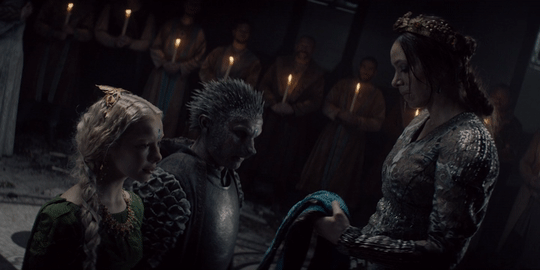
Men get all their superhero power fantasies of kicking villain ass. Finally there’s a story that has that and includes women’s emotional power fantasies about falling in love with monsters who change. It doesn’t treat either as ridiculous or limited by gender, either, since Geralt falls for a monster too and women get to kick ass as well.
Essentially, it’s a story about defeating monsters: often through integration with the shadow, sometimes involving love and connection, sometimes violence, but the violence is never glorified. It’s good.
NB: I’m in the middle of reading the books (in the middle of Blood of Elves so far). I haven’t played the game since video games aren’t really a medium I enjoy. So I’ll make some comparisons since the show covered the two books I’ve read thus far, but please don’t put spoilers for the books below!

Let’s talk my favorite aspect of every story: characters.
Renfri.
Her story was somewhat sanitized from the books (it’s a lot more brutal what happened to Renfri) but well adapted. Both versions--the book and show--depict sincere empathy for our deconstructed Snow White. I loved her dialogue with Geralt, in which Geralt praises her for escaping the huntsman her stepmother hired to kill her, and she laughs and says that she didn’t. He let her go, but not before raping and robbing her. The story never directly answers if the prophecy was true or not; Geralt doesn’t believe it, but a lot of things Geralt doubts turn out to be true. Renfri was supposedly attacking animals as a child; however, the person reporting that is highly unlikely to be unbiased (Stregobor) so is this even true? Did Renfri become a killer because she was horribly abused and left with no other option? (That’s the option that I think seems most likely.)
We can’t know. The Witcher isn’t interested in giving its audience palatable answers. It’s interested in provoking questions. The show gives more answers than do the books, again likely due to the medium, but it still lets these questions linger.
Renfri’s story is not the first one in the books, but it is the first one the show adapts, and that’s a good decision imo. Her story embodies The Witcher’s themes and questions:
By acting the monster, we make monsters out of others.
To defeat monsters, you must be a monster.
What, then, can heal, especially in a world so broken?

Ciri.
Our deconstructed Rapunzel (yes, there are a lot of fairy tale references). As far as her story goes in its adaptation, the addition of Dara was well done. Sadly, no, Dara is not in the books, but his addition gave Ciri an arc beyond merely running in this story.
That said, Ciri in the books is much younger than she is in the show. Which is okay, because Ciri is somewhat emblematic of the future: there’s a lot unknown about her powers, she needs to be protected from everyone trying to grab her and use her powers for themselves. She is Geralt’s destiny, and she is the future of the world of The Witcher.
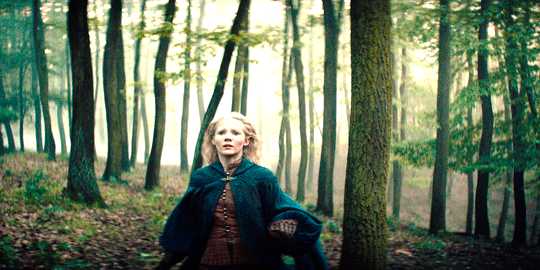
NB: I can’t discuss Ciri without shouting out to the casting director for casting Pavetta: how did they find an actress who looks so much like Ciri’s actress? It’s almost eerie.

The episode where Geralt finds out about the Law of Surprise and his reaction to Pavetta’s pregnancy is perhaps the only story that I felt was better in the show than in the books (again, this isn’t inherently a quality thing but a medium preference). It added some much-needed hilarity (Geralt’s perfectly-timed “destiny can go f--” *Pavetta vomits* and all he can say is, “fuck”) and gave Geralt an arc.
Geralt.
Mm.

I liked how they handled his character and his struggles with what it means to be a Witcher and/or human. His struggles to understand himself are relatable, and fairly well set-up for future exploration. He’s a foil of Ciri, Yennefer, Jaskier, and Cahir so far, and I’m particularly intrigued by the monster theme and the foiling that is already set up thus with all of the above except Jaskier (who is no monster). Geralt was skeptical about saving the striga for her father, but managed to succeed, and I wonder if he will somehow be able to save himself from his own inner fears/monster by being a father. (Basically, I am curious as to how being Ciri’s de factor dad is going to challenge him.)
Jaskier.

Or, Dandelion, as he’s known in the books. The bard adds some much needed levity to the tale, and as @aspoonofsugar says, he’s pretty much Donkey from Shrek. But he is used fairly well within the story: he shows Geralt even before Ciri and Yennefer enter his life that he has a purpose beyond being a killing machine. In that sense he’s the foil of Renfri (Renfri accomplishes the same, but through violence) in that Geralt saves him and he clearly thinks highly of the Witcher. Jaskier is in some ways humanity in all its paradoxes and foibles, annoying and stupid, kind and clever, funny and truthful, deceptive and respectful.
Cahir.
I’m a sucker for ravens as part of an aesthetic, as well as pretty, tormented bad boys. Yes, I know he’s a character I’m sure will arouse much handwringing and puritanical policing a la his other archetype brothers (Loki, Kylo Ren, Snape, etc). I don’t care. I do think the show made him much darker when compared to the books, but I still expect his arc to go in the same direction as the books. He’s a complicated, conflicted, complex character, and I’m not sorry for feeling empathy for him.
But I am curious about his foiling with Geralt. Both are characters seeking Ciri to fulfill... something, and monstrous in a way (Cahir more for what he does, but there’s a humanity to him as well).

Yennefer.
Finally, my favorite, my baby murder daughter.
Yennefer’s character was fascinating. I appreciated that she’s allowed to want deeply, her own wants, instead of attaching her wants to be whatever the male character desires. She wants to have children. She wants love. She wants to be beautiful. Her desires are traditionally feminine, and the show doesn’t put this down. And she also kicks ass and takes names, she fails, she’s allowed to be angry, to be mean often, to want to learn and to want to be the best.

The show doesn’t punish Yennefer for her ambition. Neither do the books. She experiences consequences, both positive and negative, for her every choice. The show reveals her backstory right away, whereas the books don’t, but again that’s a medium thing. I think both do excellently in setting up Yennefer for our empathy. It doesn’t apologize for her or her wants or actions; it lets her arc and the story itself do the talking.
Yennefer’s not here to be your cautionary tale or your role model. She’s just there to be her and to live.
That is, to an extent, perhaps the best kind of role model.
That doesn’t mean the show did everything in Yennefer’s story justice. I wasn’t thrilled with the adaptation of her first meeting with Geralt--the orgy in the background isn’t in the books and is a very bizarre decision given context. While, I loved Tissaia’s character and her foiling with Yennefer: they are too alike to ever get along, I really didn’t understand the point of Tissaia turning the other girls into slugs in episode 2. It was unsettling and not in the books. It was a heavy-handed metaphor not explained until episode 7 (about treating people as expendable slugs) that didn’t tell us anything we didn’t already know about how the world and Dark!Hogwarts worked. If anything it made the school seem foolishly cackling-mustache evil instead of the true current of darkness within it: manipulation and utilitarianism. As part of effort to control things, that control itself can lead to chaos.
I think the rest of the series set this precise dilemma of a precarious balance between self-control and manipulation/utilitarianism quite well, though (it goes hand-in-hand with the theme of a “lesser evil” to quote Renfri’s story). I’m excited to see this explored more.
Other comments:
When comparing the show to the books as I’ve read so far, I think the show made some smart changes for adapting to a visual medium. For example, Foltest and Adda’s story was adapted as a mystery: what is the monster? Who is the father? Who is the curser? Can the monster be saved? Whereas the book doesn’t do that: you know immediately that the monster is a striga, Foltest is the father, and he wants the striga saved. The answer to who cursed Adda is never clear in the written story either, whereas the show declares it was Ostrit (the book leaves it very much up in the air as to whether it was Ostrit or Adda’s mother). However, the way this particular episode weaves Adda’s story of rebirth with Yennefer’s rebirth was beautifully done. (Foltest is a good dad. We need more good dads in stories; of course, if we had more good dads, we’d have far less stories.) (I’m jesting.)
The dialogue is at times... well it’s not like it’s The Rise of Skywalker levels of “who wrote this???” but it’s not always stellar. Actually, I’d say the quality tends to swing wildly about between clever (episode 4) and just confusing (episode 5). But in general, I think the dialogue issue is representative of the show’s largest issue: it struggles to know when to trust its audience. When should it give details? When should it trust them? When is it spoonfeeding, and when is it just confusing? It tries to walk a fine line and stumbles a bit. It succeeds, however, with the characters as I mentioned earlier with Yennefer, Geralt, and Ciri.
My advice for the show going forward (not that they should definitely listen to me) is to forget Game of Thrones. It’s pretty obvious that this show is a passion project made by people who love The Witcher. I really hope they lean into that aspect instead of into the GoT-replacement aspect (because there are definitely aspects of that, particularly in the mood/aesthetic, tone, and gratuitous nudity--which is not exploitative or disturbing, but it also wasn’t necessary, isn’t in the books, and so felt like pandering).
However, the sheer love for the material still really shines through. They made me care for the characters, they interested me in the world, and they have me hooked for season 2. The showrunners’ excitement for the story and adoration of its characters is contagious, and I hope the show lets this excitement spread.
#the witcher#netflix's the witcher#geralt of rivia#yennefer of vengerberg#cahir#ciri#princess cirilla#hamliet reviews#jaskier#renfri
90 notes
·
View notes
Text
November ‘20
Cross Code
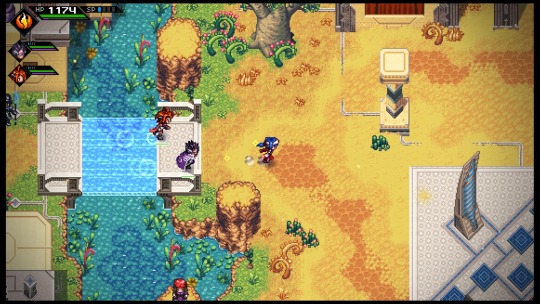
Cross Code is a game that is trying so very, very hard. The story is based around your character being an avatar within an MMORPG, and its this kind of game-within-a-game setup that is used as a cheeky way to skirt the fourth wall and have its characters make snide remarks at certain design decisions, while also going full steam ahead with them regardless of the fact. Don’t think we didn’t notice, dev team! It plays out as a 2D top-down action RPG, but clearly has aspirations that extend far beyond this framework. Each of its environments is thoroughly layered with subtle verticality, with parkour-esque platforming having you constantly working backwards from your intended destination, and requiring meticulous attention to detail in order to find where it is you’re able to begin your elaborate series of jumps from. There’s a huge array of materials to gather and channel through traders and to craft into gear, and the combat they benefit is both precise and complex, requiring plenty of on-the-fly thinking as well as tight execution. As well as these set-piece battles, the game’s dungeons are full of puzzles that though smart in construction, are tough enough in isolation, and frankly brutal in their relentless frequency. One particularly ill-advised chapter has a series of three such dungeons in quick succession, and perfectly illustrates that just because you can, does not mean that you should.
On a more positive note, one thing the game does have in spades is charm. The sprite work is admirable; even though characters are a touch on the tiny side to be too effective on their own, their portraits and dialogue provide a solid emotive connection to them and the story that builds up around them. In all, it is a game that can be a lot of fun, and plenty rewarding - but the entire thing is overly long and far too regularly punishing. It’s tapped into a number of 16-bit action-RPG ideas well, but has perhaps unintentionally also managed to become the most masochistic presentation of these ideas to date.
Crimzon Clover: World Explosion
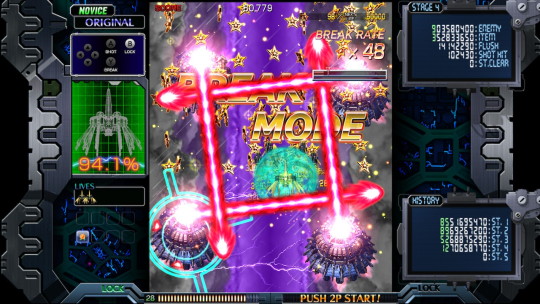
A game I’ve technically owned for years now, however the lack of a Windows PC has held me back from playing it - with this debut on the Switch finally granting me the opportunity though to get hands on. Although I’d gleaned plenty from watching super players decimate it before now, even my feeble credit feeding through the game’s five stages has given me plenty of additional appreciation for just how good it is.
It looks brilliant, with chunky, detailed enemies animated beautifully as they move about the screen. The music pounds along to an energetic beat, and the game keeps a solid pace all while plenty of bullets swarm around you in creative and considered patterns. Turning the tides with Break Mode is an incredibly satisfying way to take control of hairier moments, and while I can’t speak for every intricacy of its scoring system, I know that it’s developed by a team that demonstrably understands the value of these. What I can more reliably add to that discussion is that you’re unlikely to find yourself reliant on any one hook to find your fun though; even the most pedestrian appreciator of the genre should find plenty to enjoy. Thoroughly deserving of its regular appearance alongside the biggest names in the genre.
Holovista
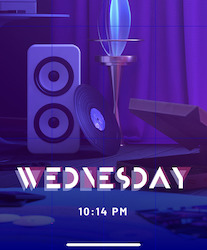
There’s often a reasonable amount of scepticism that comes from some folks when you talk of gaming on a mobile phone. Flipping the conversation though, and instead to talk of one of my favourite advantages of the format, it’s great that a developer can lean on the familiarity and the personal connection that you have to the device you’re playing on. As a device that lives by your side 24/7 and increasingly encroaches further into every aspect of your being, Holovista leverages this connection amazingly, spinning its story in a series of interfaces that mimic how your phone acts when you use it yourself. Taking pictures and interacting with people in particular are key interfaces, and that are done in a way that neatly puts you right into the shoes of their character.
It begins with said character taking an interview for a new job that is hoped to herald a new tide of good fortune, and promptly introduces the circle of friends that are there to help with this and that celebrate alongside. As you learn more about the job, things slowly begin to get a bit weird, and then take a turn that is something akin to Black Mirror meets nightmarish introspection. Though not overtly unpleasant, there are some memorably unsettling moments along the way. Sensibly, it does have content warnings that offer some sound advice for those it might not sit so well with, but self-care does end up being a central takeaway from the game as a whole as well as for its cast. On the back of circumstances we’ll generically chalk up to this year’s being what it is, this ended up feeling like a lovely little palate cleanser - a considered refresh, thoroughly original, and a very worthy afternoon’s entertainment.
The Legend of Zelda: Link’s Awakening
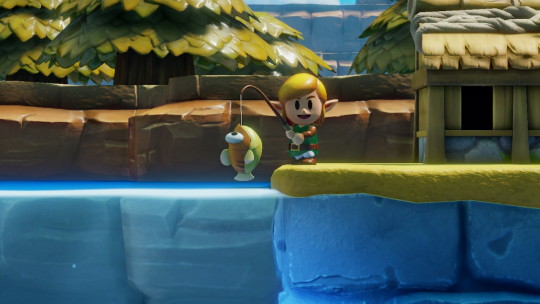
One thing that’s always been great about Link’s Awakening came as a result of the technical limitations imposed by the Gameboy - that the Zelda format needed all the fat trimmed, while the mixture of puzzles and action were to be distilled down into their most potent and compact form. Even with the (entirely optional) extras they’ve slipped in with this remake, this still shines through in its design now, where it couldn’t be any further removed from the risks of overly long, dragged out pacing. A small overworld it may be, but it’s full of variety, secrets, and memorable moments. Dungeons are similarly economical with its good ideas - giving you new tools, laying out smart ways to break you into their use, and then letting you get on with things.
While the remastered music is also utterly charming, the real upsell here is the total visual do-over; its tilt-shifted cartoon aesthetic pushing each and every scene to look like a shiny, hyper-cute diorama. For all of the different visual styles that the series has dabbled with in the past, this one definitely feels like the right match for the light-hearted whimsy that comes through from the story and the characters. That’s not to say that it’s flawless either - the blurring at the screen’s edges can be overly intense at times, and the overall presentation does cause the performance to stutter and feel a little sluggish at times. I point at these things only given the bar is raised so - something unavoidable when you already know a game is a stone-cold classic from the off.
Astro’s Playroom

Coming pre-installed on your shiny new (and hopefully not scalped) Playstation 5 console, Playroom begins as a humble introduction to the capabilities of the Dual Sense controller. Touch control, haptic feedback, adaptive triggers and the like are introduced and may well generate some cooing and low-key positivity, however this enthusiasm is elevated by a mighty factor when the game truly begins and everything is put so deftly into practice.
It’s not a complex or particularly challenging title as far as 3D platformers go, with frequent checkpoints and no life counter in sight. Any mould-breaking to be done comes instead from the diversity in how you control various sideshows, with the entire kitchen sink’s worth of interface options being showcased as you climb into a monkey suit, blast off a rocket ship, bounce around as a pinball, and so on. All of these demonstrate ingenuity that could’ve easily gone awry, yet are quickly understood, and grounded in a level of both tactile and in-game feedback that maintains a natural feeling. The game’s worlds serve as virtual tours through colourful, fantasy depictions of hardware components that demonstrates an excellent level of both pride and playfulness, with fellow bots littering both the through-fare and the unbeaten paths, dressed up and enacting smart homage to generations of games and their characters, all while Playstation-themed collectables are doled out in tandem alongside smart, well-natured puns. It arguably borders on propaganda at times, such is the intense positivity. That said, the more extensive your tenure is with Sony’s platforms, the more likely it’ll dull your better judgement to this, instead letting slip a grin at what is essentially the grandest love letter to all things Playstation, and the warmest, most celebratory pack-in for a new console Sony could have ever hoped for.
The showcasing of new features and hardware aside, it’s also a subtle and unofficial coronation of Astrobot as Sony’s newest (and best) mascot. There’s been plenty of candidates in the past who’ve half-heartedly assumed to own the position, but it’s the silent, cheerful charm which makes Astro that much more of an endearing figurehead. G'wan the little guy.
No More Heroes 2: Desperate Struggle
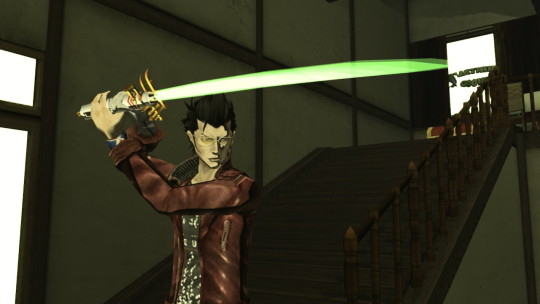
For someone that loves Suda51 and adored No More Heroes, my reaction to No More Heroes 2 on its original release was comparatively tepid. With a third game due next year, this re-release felt like the right time to revisit it and see it through, and although I found some things to enjoy, I certainly found plenty to remind me why I had bounced off it previously.
Roaming about in Santa Destroy between missions is gone, instead replaced with a short check list of destinations. While not a fan of the change myself, this isn’t necessarily a bad thing - though it does give a misleading impression of tightened focus that is very quickly lost as it lays out a spread of half-baked, and frankly clumsy mini-games. As well as being your prime source for money and upgrades, these do a lot to artificially increase the length of the game, and put simply, they’re just not fun enough to warrant this level of prominence. Even the main story has frequent moments where it veers away from the core 3D hack and slash gameplay, and again, these do more harm than good to the game’s flow.
The fighting underpinning it all has undoubtably been done better since by any number of titles, and though imperfect, it is still serviceable and enjoyable for the most part. Boss battles definitely hold the lion’s share of the game’s highlights, but there’s a few that also stick out with some poorly executed designs that tars its lasting impression. Shades do remain of the ridiculous, irreverent charm of the first game, although they are certainly more infrequent, and a more modern lens also brings into question just how sincerely we should take the sending up of Travis, when cast upon a backdrop of frequent fanservice. Not the best sequel then, but let’s hope 3 gets things back on track.
3 notes
·
View notes
Text
JUDGE PROFILE: ZOEY YING

the only sane judge on this panel! ahem, uh, i mean. out of the three judges attending this contest, zoey ying is the one with the most experience, both as a coordinator and as a judge. she’s been registered as a contest judge ever since she won that grand festival at age 11, and though she had to work a few side jobs along the way, she’s had the time since then to devote her entire heart and soul into coordinating. on top of her status as top coordinator, she’s an olympic-level figure skater who also loves skating for show, and she has trained several of her pokémon to be just as good while skating in their appeals. she has so much invested in the performing arts--she lives and breathes them in every aspect of her life. can you believe this girl is still considering law school?
as a judge, she is level-headed, honest, and above all, professional. she can be fairly blunt with her critiques, and she’s not afraid to let you know if you’ve done a bad job; in the past, she used to be a tad like simon cowell herself. but over the years, she’s gotten better at framing her critique as helpful rather than negative. it’s not impossible for her to develop some serious beef with the way a contestant comports themselves onstage; after all, she’s only human. but her strong sense of obligation always overrides it: she never lets foul emotions get in the way of doing her professional duty. in conclusion? i’m not fucking kidding when i say that zoey is the only judge whose score would be an accurate reflection of your muse’s actual ability. zoey for best girl.
LIKES.
it’s rare for zoey ying to be as flashy as her companions tobias and ursula during a performance, and it’s rare for her to like performances along their lines as well. true to her modest nature, zoey values simplicity and efficiency in a performance; she wants peoples’ and pokémons’ talents to shine through without giving the impression that they’re trying too hard. she appreciates technical complexity, but along more elegant and understated lines; too many bold visuals with no substance will bore her.
like tobias, she also enjoys more cerebral performances. appeals with symbolism and messages that you really have to think about in order to appreciate. while she’s not as educated as he is and won’t pick up on obscure references to, say, poems by little-known authors or cultural details that aren’t widely available on google, she’s smart enough to make insights about the meaning of a piece, and smart enough to reward you for them. (although if you make references to chinese history and culture, that’s right up her alley!)
she loves appeals where pokémon get to show off talents other than their moves! several of her ‘mons are figure skaters, so of course she’ll love to see that, but if they got any other things to showcase--ribbon-dancing, baton-twirling, instrument-playing--then she’ll give you a heaping dose of points!
as a chinese woman, she does have very high standards for the aesthetic of your performances. her ancestral country, after all, is the one that produced that unforgettable 2008 olympic opening ceremony, and our nation has also produced such marvels as coaching dozens of deaf dancers to flawlessly execute a dance based on the goddess of a thousand hands. being chinese has sort of spoiled her when it comes to the performing arts, and that is the sort of thought and effort she expects out of the people she observes onstage. again, though, she prefers simple yet powerful visuals. this 2008 olympics performance of 2,008 drummers chanting a line from confucius’ analects? flawless. but if the drums started changing into psychedelic colors while they were doing it? too much.
finally, she loves detail. she has an eye for the intricacy in simplicity, the beauty that comes not from the largeness and boldness of a statement but rather the nuance which makes it so powerful. elegant details that don’t overstate themselves with complexity appeal to her.
DISLIKES.
her fellow judges tobias and ursula are all about trainer participation in appeals. canonically, however, zoey has been shown to dislike performances that have too much trainer involvement in proportion to pokémon involvement. (my memory can be pretty awful sometimes, but this is one of the things that stands out in it.) since this is a showcase, in which the spotlight is more on the trainer and not the pokémon, she’s more lenient. however, if the performance is like 90% trainer and the pokémon are reduced to mere stage hands, she’s going to have an issue.
she also absolutely loathes performances that she finds to be “too loud,” no matter how well they’re done. whether it’s the loudness of the music or the loudness of the color, you can bet she’ll have something to say about it.
unlike tobias, who loves breaking the rules and greatly enjoys a good roast, zoey is very strait-laced and traditional, and will dock points of anything that she finds to be too controversial in its messaging. this includes sexual themes. unlike ursula, who finds her head easily turned by performances that are sexual or romantic in nature, zoey tends to find explicit content quite objectionable. she’s most likely asexual, like the mun, so suggestive content such as jules’ performance in the last ILWD will make her go “?????” at best, or be distasteful and unprofessional to her at worst.
a special note: as an ace-questioning woman, one of the reasons she thinks she’s ace is because she’s never been invested in romantic content. she will look at a romance-centered performance and think “that’s nice,” just like with every other performance. but if you’re expecting to move her to tears by depicting a heartbreak or the story of star-crossed lovers, you’ll be disappointed. moreover, romantic subtext--especially gay and lesbian subtext--will fly right over her head. (really ironic if you think about it, considering she’s judging a valentine’s contest.)
also due to her straitlaced traditionality, she’s not as much in favor of artistic experimentation as tobias is. while an avant-garde performance will excite him, she’ll probably just find it weird.
also unlike ursula, she doesn’t have much taste for cute and frilly things. her brand of femininity is more reserved, and she finds popping pinks and flouncing lace to be overdone and cliché.
she just really doesn’t like too much color contrast or color brightness in general. and if the colors are bright and contrasting? good fucking luck.
speaking of contrasting colors--whereas ursula will get bored by a monochrome performance, and whereas ursula likes her colors to pop, zoey is more drawn to muted pastels and greys. she also likes themed palettes instead of the arbitrary explosions of color that characterize many an amateur performance, so color-coordinating your outfit and the shades of your moves will do better in her eyes.
1 note
·
View note
Note
Favorite movies/tv shows of 2019, and why? (Also, I really like your posts and hope you post more stuff!
Thanks so much! More posts are incoming. And sorry for taking so very long to answer this.
To be honest, I don’t watch a ton of contemporary stuff. I tend to think it’s healthier to take advantage of the great wealth of great art (or weird-but-interesting art) made in all time periods than to focus on keeping up with the present. Not that I don’t watch any contemporary things, I just don’t prioritize it in any way. So this list isn’t based on me watching everything and then picking out the best. It’s based on me watching a few things and liking some of them. But I hope that even if this list isn’t any more interesting than a list of awards ceremony nominations, I might at least have something worthwhile to say about the things in question.
Recent TV:
(I’m cheating and including TV from 2017-2019 that I watched in the last year or two, or else the list would be pretty boring and short.)
Succession (2018-present) - Maybe my favorite of the shows on this list, which is surprising to me because it’s not the kind of show I normally like. I don’t tend to care about rich people being mean to each other, or art that is glossily timely. I don’t get off on seeing the private dramas of powerful, immoral people. What I like about Succession is the sense of fragility and desperation that infuses it. It’s about the human desire for these stable institutions—families, kings, corporations—and whether or not they’re actually stable, and whether or not they should be destabilized. The whole thing is just a wonderfully rich text that has been made with a lot of craft. It’s nice to know that there are people making art that is very much about the present, and has something interesting to say about it.
Fleabag (2016-present) - The second season has gotten a lot of deserved praise, so I’m not going to dwell on its merits. It’s a complex and often moving exploration of the nature of love, whether romantic, familial, physical or divine. What makes it a truly “mature” artistic work is the way that it knows what it’s about from the very beginning (“this is a love story”) and complicates that aboutness in every single episode. It’s actually interesting to compare to the first season, which lacks the same maturity. The first season is still worth watching, but it doesn’t really become clear what it’s about until the last second, when Fleabag gives her monologue in the cafe. You keep waiting for it to get to the point, instead of having a repeated sense of anticipation about the point and accompanying satisfaction every time the point-shoe drops.
Killing Eve (2018-present) - Solid entertainment. Had a bit too much of the “contemporary TV aesthetic” for me to really love. But I’d missed genuine originality and clever writing in thriller-type stories. So it’s got that going for it. (Trying to actually define the “contemporary TV aesthetic” is a problem for another post).
unREAL (2015-2018) - I only watched the first season, and don’t feel a need to watch the rest. People tell me the subsequent seasons aren’t very good anyhow. But it was doing some interesting things. Things to do with femininity, authenticity, performance and love, and the degree to which they interfere with each other. I’m planning on talking about it a bit more in a subsequent post, along with Fleabag and the movie Weekend.
Sharp Objects (2018) - Mainly watched this and unREAL because I wrote so much about Buffy season six in the last year, and I was curious about Marti Noxon’s other shows (She was the main showrunner for that season, and you can definitely tell. Unhealthy relationships, mental illness in women, rough sex, and ideas of performance seem to show up in a lot of her stuff.). She has an interesting tendency to choose “trashy” subjects, but with a refreshingly non-cute approach to the (mostly-heterosexual) female id that I respond to. I keep trying to figure out what quality Sharp Objects had that other recent art about “women being and feeling fucked up in an artistically exaggerated way” didn’t have. Things like Midsommar, The Favourite, or Gone Girl. None of which I liked. And I think it comes down to that lack of cuteness. Watching a female protagonist furtively masturbate over the memory of a murder-shack in a way that’s not about fetishizing her? Either for a male or female or political audience? It’s weirdly satisfying.
Euphoria (2019-present) - Only watched the first four episodes or so, and probably won’t watch the rest. But it was interesting to me as a pretty successful attempt to be blatantly zeitgeisty. I like its vision of contemporary life as something full of hyperstimulus (“euphoria,” get it?). Whether that’s the hyperstimulus of porn, love, attention, validation, or actual drugs. It didn’t seem to be a reactionary condemnation of all of the above, more just a depiction of it, but since I didn’t watch the whole thing I can’t comment on its attitude with certainty.
The Vietnam War (2017) - Excellent Ken Burns as usual. I appreciated the variety of perspectives he interviewed, and I appreciated the episode dedicated to Vietnam’s history before the war started. If there’s one thing that American schools suck at teaching about the Vietnam War, it’s the Vietnamese side of things. I’m not a historian so I can’t comment on how good the history in the series is. I’m sure there are important criticisms to make of it, and like all Ken Burns documentaries he uses emotional tactics to tell the story that can at times feel manipulative in a bad way. But as someone who always wanted a more in-depth, multi-sided understanding of the Vietnam War, but didn’t know where to start, I was very glad to have watched it.
Black Sails (2014-2017) - Still haven’t seen the last season. But after watching I was honestly surprised I hadn’t heard more people talking about it. Or maybe that’s just my fault for not keeping up with mainstream writing about culture. It had some fascinating themes about the nature and fragility of civilization, and I think it would be interesting to compare to Succession on that front. Black Sails features characters on the outskirts of society. Whereas Succession features characters at the center of society. But both are about the desperation for stability that leads people to make societies—and disrupt societies—in the first place.
Recent movies:
(Sticking just to 2019 this time)
Once Upon a Time In Hollywood - What I liked about this movie is that it felt like a movie. I left it feeling like I’d had a big old cineplex experience. Which was fitting, because the movie itself was about the big artificiality of film. Throughout, there is this contrast between real violence, and movie violence, and who has an understanding of them. Cliff Booth, as a stuntperson, has a “real” relationship to violence, while Rick Dalton, as an actor, does not. Cliff can cut through a cult’s fakeness, and knows to turn aside an offer of underage sex. But although Dalton does not understand authenticity, he does understand fakeness. The point of the teenage terrorists in the final act is that none of them understand either authenticity or fakeness. They don’t get that violence is real, and they don’t get that movies are fake, which leads them to being destroyed by their own movie-inspired violence. In typical Tarantino form, the movie does have a smug-feeling nyah-nyah attitude about this theme, a feeling of “you idiot loser generation, you don’t get the seriousness of violence and you also don’t get that movies are fucking fun.” But it was a theme I found interesting nonetheless.
Apollo 11 - Unequivocally loved the cinematography. Just completely aesthetically compelling to me on every level. I would have have watched an entire Koyannisqatsi devoted to it. But I feel sort of weird saying that I liked Apollo 11 as an example of contemporary movie-making, since all of that footage I loved was shot in 1969. Still, the contemporary aspect—ie, the editing—did a good job as well. Mostly because it gave the impression of staying out of the way, even though it must have been a significant effort to select and organize the footage. As well as doing animations, titling, etc. I liked that the patriotism and mythology of it was mostly just conveyed via actual soundbites from the time. And that the competent chatter of scientists was given much greater weight. I watched Free Solo the other day, a climbing documentary from 2018, and I liked it for similar reasons—the fact that the presentation gave the impression of staying out of the way of the content, despite being obviously edited.
Parasite - Pretty understandable to me that it just won Best Picture, since it’s one of the few movies from the last year that knew exactly what it was about and how to do it, and did it with unpretentious panache. I appreciated its highly cinematic use of imagery. Say, the contrast between the concrete architecture on the upper and lower levels of society— how in the upper level it’s high art, and on the lower level it’s an inhumane prison. Or the way that characters keep visually crossing lines. I was actually pretty relieved to see that Joon-ho made this movie, because I hated Snowpiercer, and kept thinking it would have been a thousand times better if it was a thousand times less metaphorical and just depicted a real-world instance of inequality in a heightened, artistic way. Which is exactly what Parasite is. In fact, I think it would be interestingly instructive to explore why Parasite succeeded in creating iconic-feeling metaphors for social inequality where Snowpiercer failed. I also appreciated its basic vision of inequality as something symbiotic, and therefore systemic, rather than a matter of mere oppression. You find yourself asking more interesting questions about how to deal with systems when you acknowledge that systems are systems, even absurd and mutable systems, in the first place. Where I think Parasite was weakest was in the pace of the storytelling. I felt myself repeatedly getting ahead of it—eg, once you realize the brother is going to get the sister a job, you’re just waiting for the movie to finish up situating the mother and father as well. Whereas I think the strongest storytelling is perfectly aware of when the audience will start anticipating something, and uses that anticipation to create complications and surprise.
An incomplete list of some other things I watched in 2019 below the cut…
Movies that I watched for the first time and liked a lot:
Brink of Life (1958), Abigail’s Party (1977), Vigil (1984), Dog Day Afternoon (1975), Resolution (2012) / The Endless (2017), Jungle Fever (1991), Festen (1998)
Movies I saw for the first time that did things I found interesting:
The Devil’s Playground (1976), Skin Game (1971), The Reflecting Skin (1990), Straight Time (1978), Late Spring (1949), Iceman (1984), Hideous Kinky (1998), Bad Company (1972), Gozu (2003), Spring (2014), Jamón Jamón (1992), eXistenZ (1999), Bull Durham (1988), Carrie (1976), Swiss Army Man (2016), Tully (2018)
Movies I saw for the first time that I’d have to write specific pros and cons for:
Cape Fear (1991), Fury (2014), Cruel Intentions (1999), White Men Can’t Jump (1992), Spiderman: Into The Spiderverse (2018), The Deer Hunter (1978), Jennifer’s Body (2009), It (2017), The Favourite (2018)
Movies I rewatched and still loved:
Night of the Living Dead (1968), Dawn of the Dead (1978), The Ring (2002), Do The Right Thing (1989), F for Fake (1973), Tampopo (1985), Girl With The Dragon Tattoo (2011), Broadcast News (1987), Tangerine (2015), Weekend (2011), Conspiracy (2001), Bicycle Thieves (1948), The Devil Wears Prada (2006), The Thing (1982), Who’s Afraid of Virginia Woolf (1966), The Hunger Games series (2012-2015)
Movies I rewatched and didn’t like as much:
Clue (1985), Before Midnight (2013), Vertigo (1958), Anchorman (2004)
16 notes
·
View notes
Text
I recently re-watched Season 1 of Fargo FX and, as is the case with every great show or movie, there were things I noticed that I had missed in earlier viewings. A few of these had to do with the portrayal of hospitals in film, which is another small obsession of mine, so I thought that I would take the time to combine these two interests and talk about the way that Fargo FX depicts hospitals. I will be mentioning the inaccuracies in this portrayal and the way that the liberties that are taken advance the plot and enhance the mood of certain scenes. By pointing out these inaccuracies, I am not trying to criticize the show or its writers, I’m just using my specific experiences to talk at length about something I love.
(Also, this post will contain big ol’ spoilers for Season 1 of Fargo FX, so go watch it if you haven’t yet and then come back.)
There are a few scenes that I wanted to discuss here, and I will bring them up chronologically. In episode 5, Lester is rushed to the hospital in an ambulance with what appears to be sepsis resulting from a shotgun pellet lodged in his hand. In the following episode, he sneaks out of the hospital to frame his brother for his wife’s murder. He does this by switching beds with his roommate, whose face is bandaged. As far as accuracy goes, it pretty much goes without saying that this concept is pretty farfetched, but I’ll run down the issues here anyway.
It’s never really clear to me what injuries require intensive care in this show (more on that later), but I will say that Lester recovers from sepsis in what must be record time. When I had more or less the same thing, my body essentially held down its own power button and restarted everything. I was in the ICU for multiple days, though I’m not sure how many because I wasn’t lucid the entire time, and I was pumped full of fluids and antibiotics, as well as hooked up to multiple tubes and wires.
Lester, however, is in excellent condition pretty much as soon as the source of his infection is removed, despite having been delirious, vomiting, sweating, shivering, and all that other fun stuff only the night before. His room seems to be on the general ward and the only thing hooked up to him is an IV, which appears to be dispensing saline and nothing else.
He is also under the care of what may be the least competent nurse I’ve ever seen in any show. Nurse Farber comes in to transport Lester’s roommate to radiology, but if she had checked his bracelet, she would have realized she was transporting the wrong patient. She also moves the entire hospital bed, rather than moving the patient to a gurney or a wheelchair, as has been my experience in the past (those beds are portable, but they’re very heavy and unwieldy).
However, these aren’t “mistakes”. They are deliberate choices that serve to move the plot along. We can’t put the story on hold so that Lester has a couple of weeks to recover and gain his strength back, so that process needs to be hurried along for the sake of the plot. If the nurse had checked his bracelet, his plan would have been foiled and, again, the plot would not be able to progress. If she had moved him to a wheelchair or gurney, he wouldn’t have been able to smuggle a change of clothes with him. So, these choices don’t arise from the writers’ ignorance of hospital procedure, they just need to bend some aspects of reality to advance the plot.
I would also like to point out some things this scene gets right about the hospital (based on my experience).
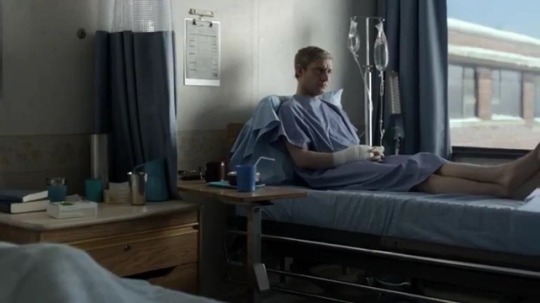
This room layout is pretty accurate. I like the little details like the plastic cup + bendy straw that everyone always has on their bedside table (even if you can lift a cup to your mouth, a bendy straw is required. It’s like an unwritten rule). I like the detail that the windows don’t open and I really appreciate that they didn’t have Lester pull out his IV like every renegade tv character seems to do. Instead, he simply disconnects the port from the tube so that he can move around, which I’m sure is more difficult than he makes it look but it’s leaps and bounds better than the old rip-em-out technique that I seem to see all the time.
I also like that the nurse uses the pain scale, which is pretty standard but I get a kick out of it. And, believe it or not, I have actually been deposited in the hall and left alone by nurses while waiting for imaging, which is how Lester manages to escape in the first place. Personally, I’ve never made it out the front door, but I haven’t tried that hard.
Now that we’ve talked about how the writers take liberties to advance the plot, let’s look at how similar inaccuracies can be used enhance the mood of a scene. If you want to see me get emotional (you sadist), get me talking about episode 7. In this episode, Molly, having been hospitalized after an emergency splenectomy, makes a trip from her room on the general ward to question Mr. Wrench, who is in custody in the ICU after having been shot twice by her (it’s not clear where he was shot, but he indicates his upper right chest, so somewhere in that area). He uses a white board to ask about his partner (Mr. Numbers) and Molly confirms that he is dead. She makes an attempt to connect with him and asks for his help in finding Lorne Malvo, but he shuts her out by refusing to look at her and she leaves. Later, in episode 8, Malvo shows up to taunt Wrench about having killed his partner, as well as to commend him for coming closer to killing him than anyone else had in the past. He gives Wrench the handcuff key and leaves.
Like I said earlier, it’s not clear what requires intensive care in this show, since Mr. Wrench doesn’t appear to be any worse off physically than Molly is (or than Lester was earlier). He does have more stuff attached to him, which is…good(?), but let’s talk about this ICU room:

This looks nothing like any ICU room I’ve ever stayed in. For one thing, in my experience the bed has always been facing the door, not inward to the rest of the room. I assume this is to make it easier to provide emergency care, which is the function of just about everything in the ICU. For this same reason, there’s very little privacy; the doors are usually clear glass and people come in and out all the time (nobody checks on patients in this show).
As I mentioned above, he has more “gear” (no, that’s not the correct term, but just be glad I didn’t call it “swag”) than either Molly or Lester, but far less than I would expect to see. There are maybe two bags on that IV pole, so probably saline and morphine (no blood/plasma/antibiotics/other medications). He’s got a heart monitor and a pulse oximeter, but no oxygen or bp monitor. Whether I like it or not, I’m always given oxygen in the ICU (which I tend to remove as soon as possible, apologies to my nurses) and if he was shot in the chest, he might actually need it. I’m also not convinced that heart monitor is working, since it doesn’t fluctuate at all when Malvo shows up in episode 8. ALSO: that bed rail should be up; I don’t care if he is handcuffed in place, that looks like a fall risk to me. Who is running this place?
(I’m also kinda jealous, because I’ve never been in an ICU room with this much natural light.)
As I mentioned before, there is specific intent behind these omissions and changes. For one thing, if there were several different machines and wires and lines and the like, the shot would be really busy and it would be distracting, both visually and auditorily, as hospital equipment tends to beep and beep and beep and beep.
Additionally, the shots are very clean, which effectively communicates a sterile environment to the audience; the natural light from the window compliments the Season 1 aesthetic really well and it also contributes somewhat to the coldness of the scenes in this room.
Speaking of which, this is as good a time as ever to bring up something I only consciously noticed very recently. Let’s go back to episode 7 and take a look at the difference between his room and Molly’s.
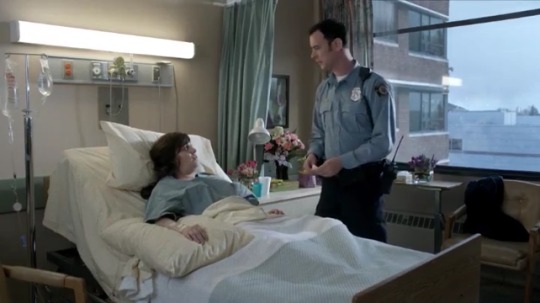
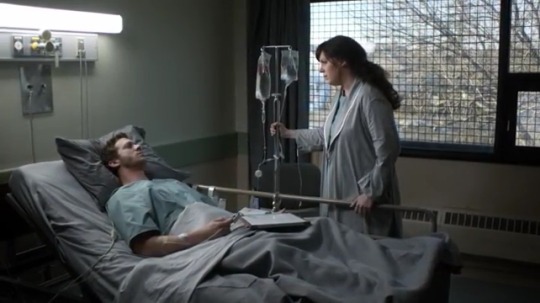
It’s very subtle, but the light above her bed is a warmer tone; her bedding is also comprised of warmer, lighter tones. Additionally, there’s some framed artwork on the wall, and most importantly she is surrounded by people (and flowers) in every shot.
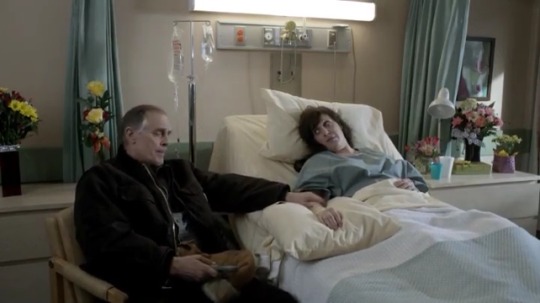
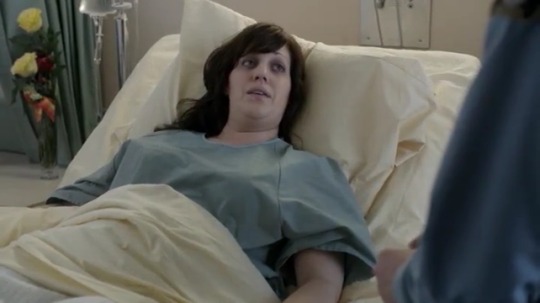
Even in reverse shots of her, the frame contains color and warm tones. Contrast this with a similar OTS shot of Wrench in his hospital room. The temperature of the scene is a lot colder and the frame surrounding him is empty, which is excellent shorthand to communicate loneliness and alienation.

His room also has some kind of mesh over the window, the practical purpose of which (if there is one) eludes me. As I mentioned earlier, hospital windows don’t open, something the writers are obviously aware of, and I’ve personally never been in a hospital room that had a grate or bars over the windows. Regardless of its practical purpose, this is another detail that contributes to the theme of isolation that is present in the design of these scenes. Being in the hospital can be a lonely, alienating experience, which is something I feel is communicated really well here.
These are subtle decisions that make a huge impact on the mood of the scene. I’m gonna be real with you right now, Mr. Wrench is my favorite character and this scene breaks my heart every time I see it. A good deal of that is owed to the quality of the show’s writing and the amazing talent of Russell Harvard and Allison Tolman, but it is always fun to see how my emotions are being relentlessly manipulated by the cinematographer as well. Good job, you guys.
I want to conclude with a proposed alternative to the staging of that last scene.

As you can see here, this scene is set during the day, with daylight clearly visible from the window. However, imagine how the emotional intensity might be different if the scene was set at night.
In my experience, nighttime in the hospital can be the most difficult, emotionally speaking, and it’s something I’ve even come to dread as a patient. For the most part, visitors have to go home, the room is dark but the lights are on in the hall and the nurses’ station. You can’t sleep because you’re uncomfortable and people keep coming in to take vitals and blood, and overall it’s very lonely.
So, imagine this scene exactly as it is played out in Season 1, but now instead of a closed off room with daylight coming through the window, the lights in the room are dimmed, it’s night outside (maybe street lights are visible through the window, but not too much). There is a soft glow coming from the heart monitor. Molly is sitting beside the bed with her back to the open door rather than the window. In the background the lights are on in the hall, you can see hospital staff going about their routine in the background. His life is falling apart in this scene, but it’s business as usual for everyone else. Even Molly, as sympathetic as she is, is just doing her job here.
I’m not saying that this staging would have been better, but it would have had a different emotional intensity. I like to see how the environment of the hospital could be used to enhance the mood of a scene, rather than simply act as a back drop because hospitals are deeply personal places, but can be so alienating at the same time. That said, I think that the way they used the environment to impart that sense of loneliness was excellent, and I support the decision to omit certain specifics that might compromise the mood or the flow of the plot.
Oh, and, if you still haven’t done it: go watch Fargo FX.
52 notes
·
View notes
Text
A perspective on the forewarning fascist iconography in GoT

Was it yesterday ? I reacted to a mind-provoking aesthetic analysis of GoT reblogged by @felixthemudnescat ... which basically no one reacted to (LOL) but... chatting with @scratchybeardsweetmouth and @ser-jorah-the-andal, I felt like revisiting it to add observations to my initial reaction. Even if it’s too heavy-meta for such a beautiful summer day. @felixthemudnescat pardon me for not using the reblog button cause I want to do this under the dot-dot-dot so as not to weigh down the usual degree of levity in our tumblr group ;-)
Also I only realized today that you actually reblogged without commenting and I assumed, maybe wrongly, that you adhered completely to what you reblogged. And that might not be the case, so I’ll alter my text accordingly...
So here we go... (my input comes at the end)
Anonymous asked:
Girl. Gurl. Who the fuck is Leni Riefenstahl? Y'all Sansa stans pulling the most elaborate nonsense out of your asses to justify shitty writing. Or you twist everything and make D&D sound as if they're the most brilliant minds the world has ever seen LOL
fedonciadale answered:
Hi there!
If you would have taken one moment to look up Leni Riefenstahl - and I assure you that it is not difficult to look her up - you would not have combined your question with a comment about the writing…. Look her up and learn a lesson about how tyrants manipulate.
The visuals of the show are alluding to famous/ notorious shots of Leni Riefenstahl. You would agree that the visuals are something that gives us hints? In addition to the dialogue?
Sansa stans have complained about the writing since season 5…. You all - I’m just assuming you are a Dany fan, correct me if I’m wrong - had no complaints about shitty writing in season 7?
Look I am not saying that the way D&D got to DarkDany this season was well executed, but the foreshadowing and the character development are there. And actually from all the things the show did Daenerys is one of the better from book to screen. The hiding of her path to ruthlessness by filming from her POV is well done in season 1 to 6, and the triumphant visuals are part of that.
Visuals are part of the foreshadowing. It did not come out of nowhere and it was always a major plot point - as has been argued by book readers for ages. That Dany blew up King’s Landing was always to be the culmination of her arc. And it was always meant to hit you in the gut. So, as you do nicely put it : get your head out of your ass as and realise that you have been duped. And ponder about why? Was it because Dany is beautiful? Was it because she had the occasional bouts of benevolence? Was it because you thought she was entitled to an ugly chair because she suffered? Was it because she was set up against people coded as villains, so that you don’t care about how she defeated them? Was it because she is a woman and woman can’t be evil?
Take your pick and learn something about yourself and your own bias, how we can be duped by a tyrant! If you do that you are doing exactly what GRRM intended his readers to do by writing Dany like he did.
une-nuit-pour-se-souvenir

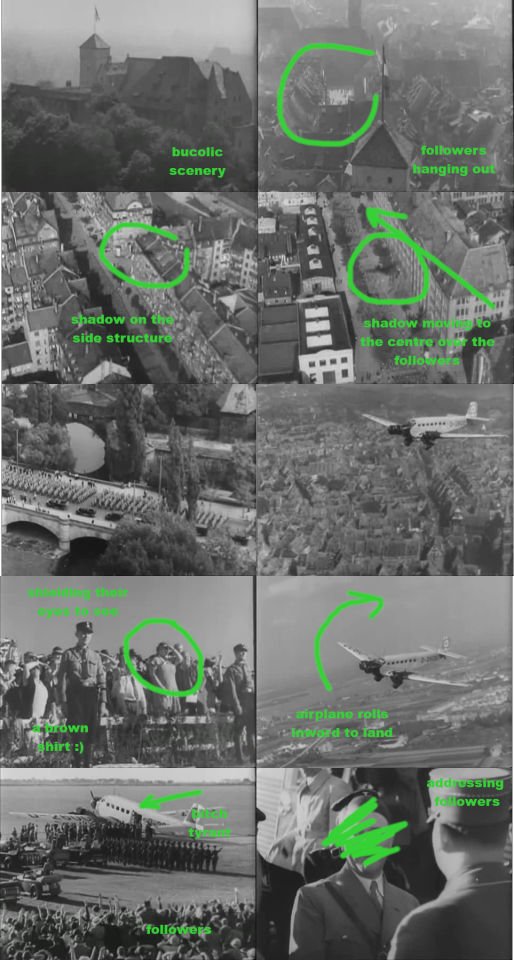

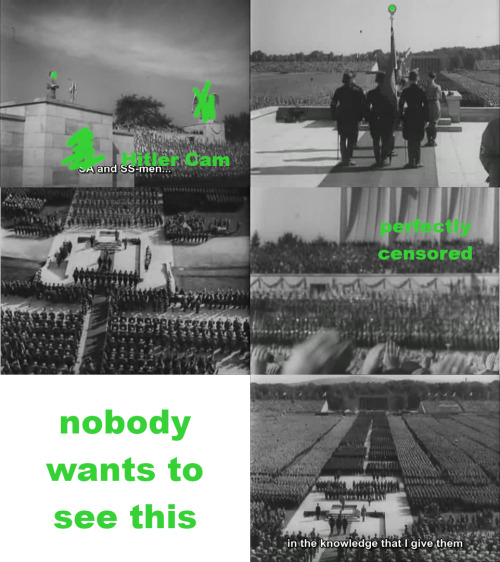
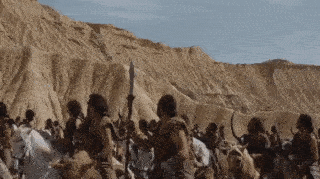


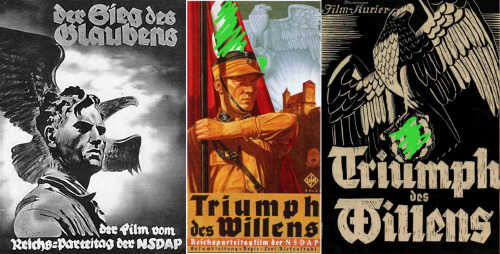

(in fiction, all these logos meant to reference the nazi flag)
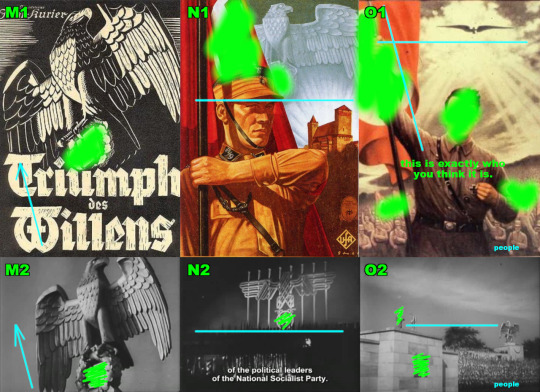



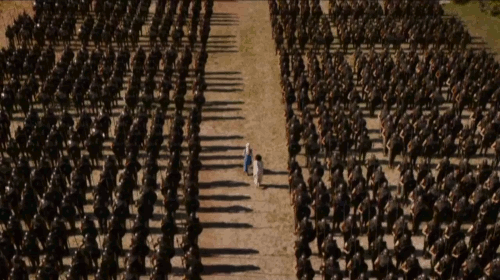
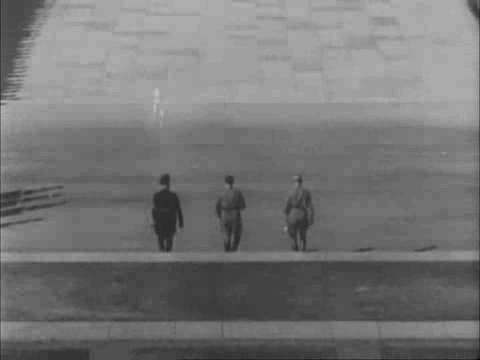




fedonciadale
Reblogging for @une-nuit-pour-se-souvenir ’s excellent additions. I could not have done that because that film is actually forbidden in Germany.
justacynicalromantic
Ohhhohohoho the last one - I am😏 at people who half a year ago threw stones at me when I argued that Dany has always had parallels with Hitler.
felixthemudnescat
Found this shared on Quora, had to re-blog!
--------------------------------------------------------------------------------------
Hi @felixthemudnescat long time no see !
I had not seen the original posting of this. My first instinctual reaction to this iconographic/aesthetics research is to object to the simple equation of Daenerys with Hitler. No fiction character will ever match the scope of evil (for lack of a better word) this man and his ideology represented. By ricochet and association, it makes every fan who was moved by Daenerys a potential Nazi sympathizer and that makes no sense. It’s also unnecessarily hurtful and insulting both to these fans and the real World (those who suffered and still suffer from The Holocaust). This said, the iconographic evidence you provided through your reblog has weight and is exactly what I referred to in some of my posts as the visual clues given in the show as to Dany’s *possible* arc, its *possible* finality (more on the *possible* further down); clues which scream at you if you have the cultural baggage to recognize them, and when you binge-watch the series 3 times in one month instead of watching it an ep at the time over 8-9 years. The middle seasons are especially ripe with these visual signs because they’re tagged unto somewhat repetitious narrative (Dany freeing/conquering one city at a time with little intimate character dev scenes). And @fedonciadale is right in wanting fans to look more closely into themselves; we shouldn’t close ours eyes on the shady ideological and moral symbols casting shadows on Daenerys throughout the seasons. But they were shadows. I don’t think they were meant to be the beginning and end to all things explaining the character.
@felixthemudnescat or @fedonciadale don’t you think D&D were building something much more subtle than the end result they opted for and which gives weight to your comparative iconographic essay ? For many seasons, the fascist references or foreboding reminders of Targaryen madness never outweighed the characterizations of Daenerys as a young woman who, regardless (or because ?) of her thwarted and abusive upbringing was trying to conjugate her own suffering and road to affirmation with the conquerer’s path given her. She might not have questioned the necessity/validity for her to conquer her way back to Westeros, as the only way she could get home, but she didn’t do it through simple rampage either. She did care to free the people she needed to build her armies. She did have a heart. This she did spontaneously; it came from a deep source within her, not a calculated one. Even if, of course, it turned out to be an astute strategy. And that sets her apart from the Nazis and its leader. At their best, D&D conjugated the two: giving us a rounded character build-up and evolution with ominous symbolic shadows lurking about her. @scratchybeardsweetmouth also made me realize, I who have not read the novels, that this humane aspect of Daenerys is brought even more to the foreground in the books. I quote @scratchybeardsweetmouth: “In the books (...) she repeatedly communicates firsthand with her freed people. She hears their opinions, is not afraid to mingle with them, always finds a way to protect them, even went out of her way to help heal some when a disease was about...” Without getting as much detailed info on her compassionate stance and actions in the show, it’s certainly the impression she indeed left us with, and it’s what her most faithful and steadfast companion, ser Jorah, sees in her and repeatedly says out loud, lest we forget it ;-) (“You have a gentle heart,” etc.)
So I thought it was IMMENSELY daring of D&D (or the novelist I’ve not read yet) to give us that scene where Daenerys is called Mhysa/Mother by the slaves she freed because the scene was inhabited with so many conflictual signs: I was all at once moved and sooooo worried as to where this could lead. Moved because, bottom line, these slaves are freed, actually freed, it’s the start of something. Dany has always given those she freed a choice to leave if they so wished… Moved because it’s a woman effecting the freeing, not a man… Moved because it’s Dany, the girl who suffered, who was a slave of sorts, that does the freeing, not her mentors…. Moved to see a culture refer to their freer as “Mother” (what a great homage to mothers, to women in general) / buuuuut also worried to see a culture refer to their freer as “Mother” because it seems to infantilize them on screen.
Here we could also open up a whole debate about the malaise one can feel in seeing an Aristocratic White Woman free Third World People but I urge you to go read @khaleesirin‘s meta writings on the subject. She makes a great case for us NOT to see Daenerys in this fashion. Regardless of her looks and lineage, the novels (and GoT, I insist in my chats with @khaleesirin ;-) shows her to be like the people she frees: an Other. She like then is homeless, uprooted, migrant, disenfranchised. If we fail to see it in Essos, the show really drives this home once Daenerys sets foot in Westeros where NO ONE welcomes, understands or appreciates her. (Which suddenly complexifies our rapport to Sansa and the Northerners we grew to love and respect since they seem not to be above xenophobia, and racism.)
But to get back to the Mhysa scene. Once the worrying starts, I can’t seem to stop it, even as I am moved to tears. Literally. Because of the above-mentioned qualities of it, and also possibly because of the Christ-like iconography it uses to celebrate Dany (”Let the little children come unto me” - if I may paraphrase the New Testament -- and thanks to @ser-jorah-the-andal for the reminder). And I’m always partial to feminizations of Christ; I love it, I think it’s sublimely subversive :-) But I’m also kicking myself for liking this because I fundamentally don’t want a Messiah saving the Third World, I want the Third World to save itself... and I’m worried. I’m really worried as I watch Daenerys triumph in this scene because we know she’s lacking important elements in her “psycho-affective and socio-political tool kit” (regardless of the quality and loving care of advisers now on hand, *cough* Jorah -- in the books @scratchybeardsweetmouth tells me she needs no advisor to keep her moral compass straight) and, so, will this get to her head ? Will she get drunk on her Messiah complex (and of course she does at the end of season 8) ? And what will happen if those she freed disappoint her (again flashforward to the end of season 8) ? And how will she rule them exactly (ditto) ? And, finally, yes, worried because, the fascist iconography is there and I’m going: omg where are they going with this ?
Here I want to open another parenthesis, also brought on by something @ser-jorah-the-andal wrote me: “if this is what they meant in the first place, they sure as hell didn’t bother to tell anyone in the cast so they could act accordingly, tho a case could be made that Dany never saw herself as the villain so that’s why they didn’t tell Emilia.” Indeed I’m sure the cast, or at the very least Emilia Clarke, were never told about the endgame, or never cued to the quoting of fascist iconography in some of Daenerys’ triumphant scenes. Clarke’s shocked reaction upon reading the last screenplays is a testament to her profound surprise... and this raises ethical questions, doesn’t it ? I mean in the ethics of creative partnership. It’s a recent debate possibly because there are so many tales of directors manipulating actors into giving them the performance needed to embody and communicate the discourse they want to leave us with. But the professional in me cringes here a bit. You’d hope they would trust actors enough to let them into what it is exactly they’re supposed to be creating...
This said, up to the moment before “the bells” scene in season 8, I had nonetheless seen D+D and EC give us a woman struggling morally with her choices. That’s important to state. And to get back to the above demonstration of fascist parallels, well, please, let’s point out that the Nazis and their leader never did struggle morally with what they were doing (or if they did, History bears no markers -- I’m talking about the Nazis here, not the German people as a whole). And I was prepared to see Daenerys fail because she never healed, she never achieved psycho-affective soundness (shall we get into the chapter of her misconstruing what love is ? Her relationship arc with Jorah speaks volumes) but I was expecting her to feel remorse if she did succumb to true fascism; remorse to the point of self-execution if you will, because that’s the kind of moral person D+D had been building for 7 years. But after D&D sent her over the edge, they erased all the previous nuances they had built into her, and I believe, tried to explained it away with a broken heart, megalomania and madness….
So if their plan was truly to make us see her as a fascist leader of the scope we’re talking about here, the way the above visual essay seems to suggest, they would have fleshed out her character’s arc accordingly throughout the seasons, and they didn’t. There were clues as to the possibilities -- yes, Dany stepping out for her final speech is absolutely shot like Triumph of the Will by Riefenstahl… but it’s also infused with other iconographic references. That image of her merging with Drogon’s wings belongs to the fantastic, and makes her into a formidable and powerful Id, which can be construed as a positive subversive marker. And some of us do celebrate WrathfulDany for this reason....
The reality of GoT is that there were no actual scenes developing her fascist ideology. So let’s not confuse allusions to fascism with actual fascism. With all D+D’s failings towards the end, Daenerys remained a more nuanced and contradictory character than that. She is NOT Hitler, please......
The iconographic research you provided in your reblog @felixthemudnescat show us one important aspect of Dany’s subtextual arc but not the full picture. It’s missing the heart and the suffering behind the soul who fell from grace.
I hope you don’t construe this long winding reaction as a slam. I know you come from a very specific place in regards to Daenerys. I just thought the excellent research you provided deserved to be reblogged, but with an added perspective ;-)
54 notes
·
View notes